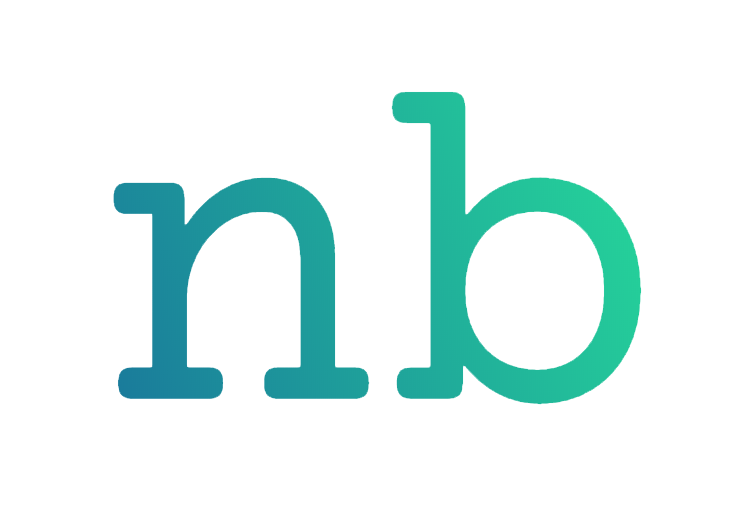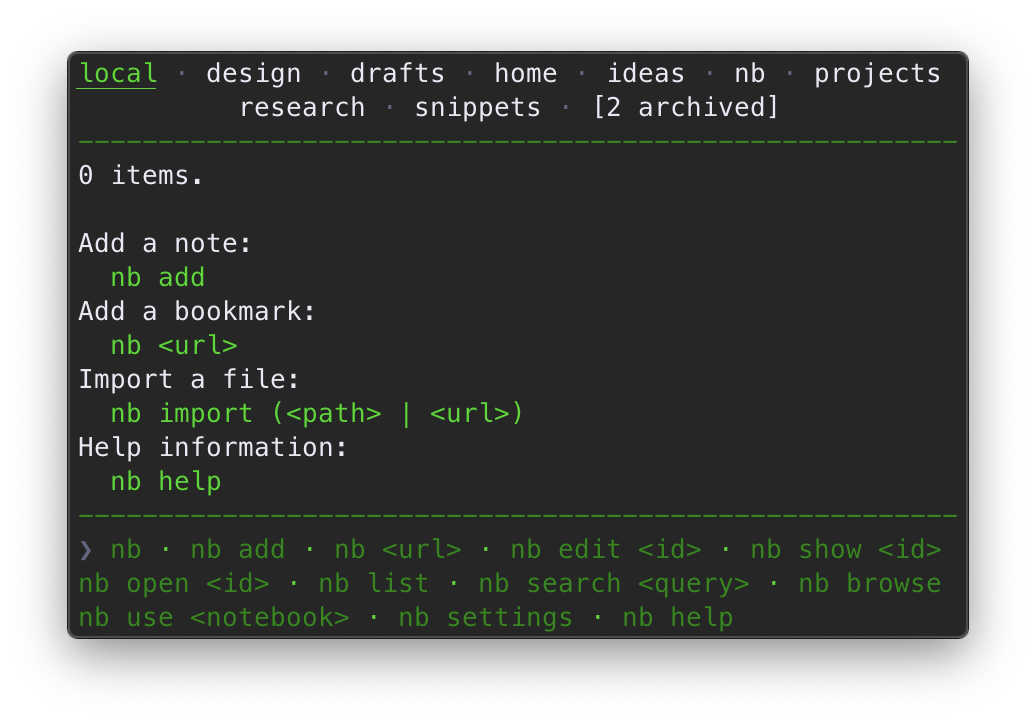nb is a command line note-taking, bookmarking, archiving,
and knowledge base application with:
- plain-text data storage,
- encryption,
- filtering, pinning, #tagging, and search,
- Git-backed versioning and syncing,
- Pandoc-backed conversion,
- [[wiki-style linking]] with terminal-first browsing,
- global and local notebooks,
- customizable color themes,
- extensibility through plugins,
and more, all in a single portable, user-friendly script.
nb creates notes in text-based formats like
Markdown,
Org,
and LaTeX,
can work with files in any format, can import and export notes to many
document formats, and can create private, password-protected encrypted
notes and bookmarks. With nb, you can write notes using Vim, Emacs,
VS Code, Sublime Text, and any other text editor you like. nb works in
any standard Linux / Unix environment, including macOS and Windows via WSL.
Optional dependencies can be installed to enhance functionality,
but nb works great without them.
nb is also a powerful text-based CLI bookmarking system that includes:
- local full-text search of cached page content with regular expression support,
- tagging,
- convenient filtering and listing,
- Internet Archive Wayback Machine snapshot lookup for broken links,
- easy viewing of bookmarked pages in the terminal and your regular web browser.
Page information is automatically downloaded, compiled, and saved into normal Markdown documents made for humans, so bookmarks are easy to edit just like any other note.
nb uses Git in the background to automatically
record changes and sync notebooks with remote repositories.
nb can also be configured to sync notebooks using a general purpose
syncing utility like Dropbox so notes can be edited in other apps
on any device.
nb is designed to be portable, future-focused, and vendor independent,
providing a full-featured and intuitive experience within a highly composable
user-centric text interface.
The entire program is a single well-tested
shell script that can be
installed, copied, or curled almost anywhere and just work, using
a strategy inspired by
progressive enhancement
for various experience improvements in more capable environments. nb works great
whether you have one notebook with just a few notes or dozens of
notebooks containing thousands of notes, bookmarks, and other items.
nb makes it easy to incorporate other tools, writing apps, and workflows.
nb can be used a little, a lot, once in a while, or for just a subset of
features. nb is flexible.
📝 🔖 🔒 🔍 📔
Versions: 6.0.0-alpha • 5.7.8
Installation • Overview • Help
- Bash
nbworks perfectly with Zsh, fish, and any other shell set as your primary login shell, the system just needs to have Bash available on it.
- Git
- A text editor with command line support, such as:
nb leverages standard command line tools and works in standard
Linux / Unix environments. nb also checks the environment for some
additional optional tools and uses them to enhance the experience whenever
they are available.
Recommended:
Also supported for various enhancements:
Ack,
afplay,
Ag - The Silver Searcher,
exa,
ffplay,
ImageMagick,
GnuPG,
highlight,
imgcat,
kitty's icat kitten,
Links,
Lynx,
Midnight Commander,
mpg123,
MPlayer,
ncat,
note-link-janitor
(via plugin),
pdftotext,
Pygments,
Ranger,
readability-cli,
rga / ripgrep-all,
termpdf.py,
vifm
To install version 5.7.8 with Homebrew:
brew tap xwmx/taps
brew install nbInstalling nb with Homebrew also installs the recommended dependencies
above and completion scripts for Bash and Zsh.
To install version 5.7.8 with npm:
npm install -g nb.shAfter npm installation completes, run
sudo "$(which nb)" completions install
to install Bash and Zsh completion scripts (recommended).
On Ubuntu and WSL, you can run sudo "$(which nb)" env install
to install the optional dependencies.
nb is also available under its original package name,
notes.sh,
which comes with an extra notes executable wrapping nb.
To install as an administrator, copy and paste one of the following multi-line commands:
# install using wget
sudo wget https://raw.github.com/xwmx/nb/master/nb -O /usr/local/bin/nb &&
sudo chmod +x /usr/local/bin/nb &&
sudo nb completions install
# install using curl
sudo curl -L https://raw.github.com/xwmx/nb/master/nb -o /usr/local/bin/nb &&
sudo chmod +x /usr/local/bin/nb &&
sudo nb completions installOn Ubuntu and WSL, you can run sudo nb env install to install
the optional dependencies.
To install with just user permissions, simply add the nb script to your
$PATH. If you already have a ~/bin directory, for example, you can use
one of the following commands:
# download with wget
wget https://raw.github.com/xwmx/nb/master/nb -O ~/bin/nb && chmod +x ~/bin/nb
# download with curl
curl -L https://raw.github.com/xwmx/nb/master/nb -o ~/bin/nb && chmod +x ~/bin/nbInstalling with just user permissions doesn't include the optional
dependencies or completions, but nb works without them. If you have
sudo access and want to install the completion scripts and
dependencies, run the following command:
sudo nb env installTo install with Make, clone this repository, navigate to the clone's root directory, and run:
sudo make installThis will also install the completion scripts on all systems and the recommended dependencies on Ubuntu and WSL.
To install with bpkg:
bpkg install xwmx/nbBash and Zsh tab completion should be enabled when nb is installed using
the methods above, assuming you have the appropriate system
permissions or installed with sudo. If completion isn't working after
installing nb, see the completion installation
instructions.
When nb is installed using a package manager like npm or
Homebrew, use the package manager's upgrade functionality to update nb to
the latest version. When installed via other methods, nb can be updated to
the latest version using the nb update subcommand.
Notes •
Adding •
Listing •
Editing •
Viewing •
Deleting •
Bookmarks •
Tagging •
Linking •
Browsing •
Zettelkasten •
Folders •
Pinning •
Search •
History •
Notebooks •
Git Sync •
Import / Export •
set & Settings •
Color Themes •
Plugins •
Shell •
Shortcuts •
Help •
Specifications •
Tests
Some new features described below are currently available in the git repository and will be included in version 6.0.0.
To get started, simply run:
nbnb sets up your initial "home" notebook the first time it runs.
By default, notebooks and notes are global (at ~/.nb), so they are always available to
nb regardless of the current working directory. nb also supports
local notebooks.
Use nb add to create new notes:
# create a new note in your text editor
nb add
# create a new note with the filename "example.md"
nb add example.md
# create a new note containing "This is a note."
nb add "This is a note."
# create a new note with piped content
echo "Note content." | nb add
# create a new password-protected, encrypted note titled "Secret Document"
nb add --title "Secret Document" --encrypt
# create a new note in the notebook named "example"
nb example:add "This is a note."
# create a new note in the folder named "sample"
nb add sample/nb add with no arguments or input will open the new, blank note in your
environment's preferred text editor. You can change your editor using the
$EDITOR environment variable or nb set editor.
nb files are Markdown
files by default. The default file type can be changed to whatever you
like using nb set default_extension.
nb add has smart argument parsing and behaves differently depending on
the types of arguments it receives. When a filename with extension is
specified, a new note with that filename is opened in the editor:
nb add example.mdWhen a string is specified, a new note is immediately created with that string as the content and the editor is not opened:
> nb add "This is a note."
Added: [1] 20200101000000.mdnb add <string> is useful for quickly jotting down notes directly
via the command line. Quoting content is optional, but recommended.
When no filename is specified, nb add uses the current datetime as
the filename.
nb add can also recieve piped content, which behaves the same as
nb add <string>:
# create a new note containing "Note content."
> echo "Note content." | nb add
Added: [6] 20200101000100.md
# create a new note containing the clipboard contents on macOS
> pbpaste | nb add
Added: [7] 20200101000200.md
# create a new note containing the clipboard contents using xclip
> xclip -o | nb add
Added: [8] 20200101000300.mdContent can be passed with the --content option, which will also
create a new note without opening the editor:
nb add --content "Note content."When content is piped, specified with --content, or passed as a
string argument, use the --edit flag to open the file in the editor
before the change is committed.
The title, filename, and content can also be specified with long and short options:
> nb add --filename "example.md" -t "Example Title" -c "Example content."
Added: [9] example.md "Example Title"The -t <title> / --title <title> option will also set the filename
to the title, lowercased with spaces and non-filename characters replaced
with underscores:
> nb add --title "Example Title" "Example content."
Added: [10] example_title.md "Example Title"Tags can be added with the --tags <tag1>,<tag2>... option, which takes
a comma separated list of tags, converts them to
#hashtags, and inserts them between the title and content:
> nb add "Example content." --title "Tagged Example" --tags tag1,tag2
Added: [11] tagged_example.md "Tagged Example"
> nb show 11 --print
# Tagged Example
#tag1 #tag2
Example content.Search for tagged items with nb search / nb q:
nb search "#tag1" "#tag2"Files can be created with any file type either by specifying the
extension in the filename, the extension by itself, or via
the --type <type> option:
# open a new Org file in the editor
nb add example.org
# open a new reStructuredText file in the editor
nb add --type rst
# open a new JavaScript file in the editor
nb add .jsCombining a type argument with piped clipboard content provides a very
convenient way to save code snippets using a clipboard utility such as
pbpaste, xclip, or
pb:
# save the clipboard contents as a JavaScript file in the current notebook
pb | nb add .js
# save the clipboard contents as a Rust file in the "rust" notebook
# using the shortcut alias `a`
pb | nb a rust: .rs
# save the clipboard contents as a Haskell file named "example.hs" in the
# "snippets" notebook using the shortcut alias `a`
pb | nb a snippets: example.hsUse nb show to view code snippets with automatic syntax
highlighting and nb edit to open in your editor.
Piping, --title <title>, --tags <tag-list>, --content <content>, and
content passed in an argument can be combined as needed to create notes
with content from multiple input methods and sources using a single
command:
> pb | nb a "Argument content." \
--title "Sample Title" \
--tags tag1,tag2 \
--content "Option content."
Added: [12] sample_title.md "Sample Title"
> nb show 12 --print
# Sample Title
#tag1 #tag2
Argument content.
Option content.
Clipboard content.For a full list of options available for nb add, run nb help add.
Password-protected notes and bookmarks are created with
the -e / --encrypt flag and are encrypted with AES-256 using OpenSSL
by default. GPG is also supported and can be configured with
nb set encryption_tool.
Each protected note and bookmark is encrypted individually with its own
password. When an encrypted item is viewed, edited, or opened, nb
will simply prompt for the item's password before proceeding. After an
item is edited, nb automatically re-encrypts it and saves the new
version.
Encrypted notes can also be decrypted using the OpenSSL and GPG command
line tools directly, so you aren't dependent on nb to decrypt your
files.
nb includes single-character shortcuts for many commands, including
a for add:
# create a new note in your text editor
nb a
# create a new note with the filename "example.md"
nb a example.md
# create a new note containing "This is a note."
nb a "This is a note."
# create a new note containing the clipboard contents with xclip
xclip -o | nb a
# create a new note in the notebook named "example"
nb example:anb add can also be invoked with nb create and nb new for convenience:
# create a new note containing "Example note content."
nb new "Example note content."
# create a new note with the title "Example Note Title"
nb create --title "Example Note Title"To list notes and notebooks, run nb ls:
> nb ls
home
----
[3] example.md · "Example content."
[2] todos.md · "Todos:"
[1] ideas.md · "- Example idea one."Notebooks are listed above the line, with the current notebook
highlighted and/or underlined, depending on terminal capabilities.
nb ls also includes a footer with example commands for easy reference.
The notebook header and command footer can be configured or hidden with
nb set header and
nb set footer.
Notes from the current notebook are listed in the order they were last modified. By default, each note is listed with its id, filename, and an excerpt from the first line of the note. When a note has a title, the title is displayed instead of the filename and first line.
Markdown titles can be defined within a note using
either Markdown h1 style
or YAML front matter:
# Example TitleTodos
=====---
title: Ideas
---Org and LaTeX
titles are recognized in .org and .latex files:
#+TITLE: Example Org Title
\title{Example LaTeX Title}Once defined, titles are displayed in place of the filename and first line
in the output of nb ls:
> nb ls
home
----
[3] Example Title
[2] Todos
[1] IdeasPass an id, filename, or title to view the listing for that note:
> nb ls Todos
[2] Todos> nb ls 3
[3] Example TitleIf there is no exact match, nb will list items with titles and
filenames that fuzzy match the query:
> nb ls "idea"
[1] IdeasA case-insensitive regular expression can also be used to filter filenames and titles:
> nb ls "^example.*"
[3] Example TitleMultiple words act like an OR filter, listing any titles or filenames that
match any of the words:
> nb ls example ideas
[3] Example Title
[1] IdeasWhen multiple words are quoted, filter titles and filenames for that phrase:
> nb ls "example title"
[3] Example TitleFor full text search, see Search.
To view excerpts of notes, use the --excerpt or -e option, which
optionally accepts a length:
> nb ls 3 --excerpt
[3] Example Title
-----------------
# Example Title
This is an example excerpt.
> nb ls 3 -e 8
[3] Example Title
-----------------
# Example Title
This is an example excerpt.
More example content:
- one
- two
- threeSeveral classes of file types are represented with emoji to make them
easily identifiable in lists. For example, bookmarks and encrypted notes
are listed with 🔖 and 🔒:
> nb ls
home
----
[4] Example Note
[3] 🔒 encrypted-note.md.enc
[2] 🔖 Example Bookmark (example.com)
[1] 🔖 🔒 encrypted.bookmark.md.encFile types include:
🔉 Audio
📖 Book
🔖 Bookmark
🔒 Encrypted
📂 Folder
🌄 Image
📄 PDF, Word, or Open Office document
📹 Video
By default, items are listed starting with the most recently modified.
To reverse the order, use the -r or --reverse flag:
> nb ls
home
----
[2] Todos
[3] Example Title
[1] Ideas
> nb ls --reverse
[1] Ideas
[3] Example Title
[2] TodosNotes can be sorted with the -s / --sort flag, which can be combined
with -r / --reverse:
> nb ls
home
----
[2] Todos
[3] Example Title
[1] Ideas
> nb ls --sort
[1] Ideas
[2] Todos
[3] Example Title
> nb ls --sort --reverse
[3] Example Title
[2] Todos
[1] Ideasnb with no subcommand behaves like an alias for nb ls, so the examples
above can be run without the ls:
> nb
home
----
[2] Todos
[3] Example Title
[1] Ideas
> nb "^example.*"
[3] Example Title
> nb 3 --excerpt
[3] Example Title
-----------------
# Example Title
This is an example excerpt.
> nb 3 -e 8
[3] Example Title
-----------------
# Example Title
This is an example excerpt.
More example content:
- one
- two
- three
> nb --sort
[1] Ideas
[2] Todos
[3] Example Title
> nb --sort --reverse
[3] Example Title
[2] Todos
[1] IdeasShort options can be combined for brevity:
# equivalent to `nb --sort --reverse --excerpt 2` and `nb -s -r -e 2`:
> nb -sre 2
[3] Example Title
-----------------
# Example Title
[2] Todos
---------
Todos
=====
[1] Ideas
---------
---
title: Ideasnb and nb ls display the 20 most recently modified items. The default
limit can be changed with nb set limit <number>.
To list a different number of items on a per-command basis, use the
-n <limit>, --limit <limit>, --<limit>, -a, or --all flags:
> nb -n 1
home
----
[5] Example Five
4 omitted. 5 total.
> nb --limit 2
home
----
[5] Example Five
[4] Example Four
3 omitted. 5 total.
> nb --3
home
----
[5] Example Five
[4] Example Four
[3] Example Three
2 omitted. 5 total.
> nb --all
home
----
[5] Example Five
[4] Example Four
[3] Example Three
[2] Example Two
[1] Example Onenb ls is a combination of nb notebooks and nb list
in one view and accepts the same arguments as nb list, which lists only
notes without the notebook list and with no limit by default:
> nb list
[100] Example One Hundred
[99] Example Ninety-Nine
[98] Example Ninety-Eight
... lists all notes ...
[2] Example Two
[1] Example OneFor more information about options for listing notes, run nb help ls
and nb help list.
You can edit a note in your editor by passing its id, filename, or title
to nb edit:
# edit note by id
nb edit 3
# edit note by filename
nb edit example.md
# edit note by title
nb edit "A Document Title"
# edit note 12 in the notebook named "example"
nb edit example:12
# edit note 12 in the notebook named "example", alternative
nb example:12 edit
# edit note 12 in the notebook named "example", alternative
nb example:edit 12edit and other subcommands that take an identifier can be called with the
identifier and subcommand name reversed:
# edit note by id
nb 3 editnb edit can also receive piped content, which it will append to the
specified note without opening the editor:
echo "Content to append." | nb edit 1Content can be passed with the --content option, which will also
append the content without opening the editor:
nb edit 1 --content "Content to append."Use the --overwrite option to overwrite existing file content and
the --prepend option to prepend the new content before existing
content.
When content is piped or specified with --content, use the --edit
flag to open the file in the editor before the change is committed.
When a note is encrypted, nb edit will prompt you for the note password,
open the unencrypted content in your editor, and then automatically reencrypt
the note when you are done editing.
Like add, edit has a shortcut alias, e:
# edit note by id
nb e 3
# edit note by filename
nb e example.md
# edit note by title
nb e "A Document Title"
# edit note by id, alternative
nb 3 e
# edit note 12 in the notebook named "example"
nb e example:12
# edit note 12 in the notebook named "example", alternative
nb example:12 e
# edit note 12 in the notebook named "example", alternative
nb example:e 12For nb edit help information, run nb help edit.
Notes can be viewed using nb show:
# show note by id
nb show 3
# show note by filename
nb show example.md
# show note by title
nb show "A Document Title"
# show note by id, alternative
nb 3 show
# show note 12 in the notebook named "example"
nb show example:12
# show note 12 in the notebook named "example", alternative
nb example:12 show
# show note 12 in the notebook named "example", alternative
nb example:show 12By default, nb show will open the note in
less, with syntax highlighting if
bat,
highlight,
or
Pygments
is installed. You can navigate in less using the following keys:
Key Function
--- --------
mouse scroll Scroll up or down
arrow up or down Scroll one line up or down
f Jump forward one window
b Jump back one window
d Jump down one half window
u Jump up one half window
/<query> Search for <query>
n Jump to next <query> match
q Quit
If less scrolling isn't working in iTerm2,
go to "Settings" -> "Advanced" -> "Scroll wheel sends arrow keys when in
alternate screen mode" and change it to "Yes".
More info
Use the -p / --print option to print to standard output with syntax
highlighting:
> nb show 123 --print
# Example Title
Example content:
- one
- two
- threeUse nb show --print --no-color to print without syntax highlighting.
When Pandoc is available, use the -r / --render
option to render the note to HTML and open it in your terminal browser:
nb show example.md --render
# opens example.md as an HTML page in w3m, links, or lynxnb show also supports previewing other file types in the terminal,
depending on the tools available in the environment. Supported file types and
tools include:
- PDF files:
termpdf.pywith kittypdftotext
- Audio files:
- Images:
- ImageMagick with a terminal that supports sixels
imgcatwith iTerm2- kitty's
icatkitten
- Folders / Directories:
- Word Documents:
- EPUB ebooks:
When using nb show with other file types or if the above tools are not
available, nb show will open files in your system's preferred application
for each type.
nb show also provides options for querying information about an
item. For example, use the --added / -a and --updated / -u flags to
print the date and time that an item was added or updated:
> nb show 2 --added
2020-01-01 01:01:00 -0700
> nb show 2 --updated
2020-02-02 02:02:00 -0700nb show is primarily intended for viewing items within the terminal.
To view a file in the system's preferred GUI application,
use nb open.
For full nb show usage information, run nb help show.
show is aliased to s:
# show note by id
nb s 3
# show note by filename
nb s example.md
# show note by title
nb s "A Document Title"
# show note by id, alternative
nb 3 s
# show note 12 in the notebook named "example"
nb s example:12
# show note 12 in the notebook named "example", alternative
nb example:12 s
# show note 12 in the notebook named "example", alternative
nb example:s 12nb show can also be invoked with nb view for convenience:
# show note by id
nb view 3
# show note by filename
nb view example.md
# show note by title
nb view "A Document Title"
# show note by id, alternative
nb 3 viewTo delete a note, pass its id, filename, or title to
nb delete:
# delete note by id
nb delete 3
# delete note by filename
nb delete example.md
# delete note by title
nb delete "A Document Title"
# delete note by id, alternative
nb 3 delete
# delete note 12 in the notebook named "example"
nb delete example:12
# delete note 12 in the notebook named "example", alternative
nb example:12 delete
# show note 12 in the notebook named "example", alternative
nb example:delete 12By default, nb delete will display a confirmation prompt. To skip, use the
--force / -f option:
nb delete 3 --forcedelete has the alias d:
# delete note by id
nb d 3
# delete note by filename
nb d example.md
# delete note by title
nb d "A Document Title"
# delete note by id, alternative
nb 3 d
# delete note 12 in the notebook named "example"
nb d example:12
# delete note 12 in the notebook named "example", alternative
nb example:12 d
# delete note 12 in the notebook named "example", alternative
nb example:d 12For nb delete help information, run nb help delete.
nb is a powerful bookmark management system, enabling you to to view, search,
and manage your bookmarks, links, and online references. Bookmarks are
Markdown notes containing information about the bookmarked page.
To create a new bookmark pass a URL as the first argument to nb:
nb https://example.comnb automatically generates a bookmark using information from the page:
# Example Title (example.com)
<https://example.com>
## Description
Example description.
## Content
Example Title
=============
This domain is for use in illustrative examples in documents. You may
use this domain in literature without prior coordination or asking for
permission.
[More information\...](https://www.iana.org/domains/example)nb embeds the page content in the bookmark, making it available for full
text search with nb search. When Pandoc
is installed, the HTML page content will be converted to Markdown. When
readability-cli is
installed, markup is cleaned up to focus on content.
In addition to caching the page content, you can also include a quote from
the page using the -q / --quote option:
nb https://example.com --quote "Example quote line one.
Example quote line two."# Example Title (example.com)
<https://example.com>
## Description
Example description.
## Quote
> Example quote line one.
>
> Example quote line two.
## Content
Example Title
=============
This domain is for use in illustrative examples in documents. You may
use this domain in literature without prior coordination or asking for
permission.
[More information\...](https://www.iana.org/domains/example)Add a comment to a bookmark using the -c / --comment option:
nb https://example.com --comment "Example comment."# Example Title (example.com)
<https://example.com>
## Description
Example description.
## Comment
Example comment.
## Content
Example Title
=============
This domain is for use in illustrative examples in documents. You may
use this domain in literature without prior coordination or asking for
permission.
[More information\...](https://www.iana.org/domains/example)Bookmarks can be tagged using the -t / --tags option. Tags are converted
into #hashtags:
nb https://example.com --tags tag1,tag2# Example Title (example.com)
<https://example.com>
## Description
Example description.
## Tags
#tag1 #tag2
## Content
Example Title
=============
This domain is for use in illustrative examples in documents. You may
use this domain in literature without prior coordination or asking for
permission.
[More information\...](https://www.iana.org/domains/example)Search for tagged bookmarks with nb search / nb q:
nb search "#tag1"
nb q "#tag"nb search / nb q automatically searches archived page content:
> nb q "example query"
[10] 🔖 example.bookmark.md "Example Bookmark (example.com)"
------------------------------------------------------------
5:Lorem ipsum example query.Bookmarks can also be encrypted:
# create a new password-protected, encrypted bookmark
nb https://example.com --encryptEncrypted bookmarks require a password before they can be viewed or opened.
nb bookmark and nb bookmark list can be used to list
and filter only bookmarks:
> nb bookmark
Add: nb <url> Help: nb help bookmark
------------------------------------
[3] 🔖 🔒 example.bookmark.md.enc
[2] 🔖 Bookmark Two (example.com)
[1] 🔖 Bookmark One (example.com)
> nb bookmark list two
[2] 🔖 Bookmark Two (example.com)Bookmarks are also included in nb, nb ls, and nb list:
> nb
home
----
[7] 🔖 Bookmark Three (example.com)
[6] Example Note
[5] 🔖 Bookmark Two (example.net)
[4] Sample Note
[3] 🔖 🔒 example-encrypted.bookmark.md.enc
[2] Demo Note
[1] 🔖 Bookmark One (example.com)Use the --type <type> / --<type> option as a filter to display
only bookmarks:
> nb --type bookmark
[7] 🔖 Bookmark Three (example.com)
[5] 🔖 Bookmark Two (example.net)
[3] 🔖 🔒 example-encrypted.bookmark.md.enc
[1] 🔖 Bookmark One (example.com)
> nb --bookmark
[7] 🔖 Bookmark Three (example.com)
[5] 🔖 Bookmark Two (example.net)
[3] 🔖 🔒 example-encrypted.bookmark.md.enc
[1] 🔖 Bookmark One (example.com)nb saves the domain in the title, making it easy to filter by domain
using any list subcommands:
> nb example.com
[7] 🔖 Bookmark Three (example.com)
[1] 🔖 Bookmark One (example.com)For more listing options, see nb help ls, nb help list,
and nb help bookmark.
bookmark can also be used with the alias b:
> nb b
Add: nb <url> Help: nb help bookmark
------------------------------------
[7] 🔖 Bookmark Three (example.com)
[5] 🔖 Bookmark Two (example.net)
[3] 🔖 🔒 example-encrypted.bookmark.md.enc
[1] 🔖 Bookmark One (example.com)
> nb b example.net
[5] 🔖 Bookmark Two (example.net)nb provides multiple ways to view bookmarked web pages.
nb open opens the bookmarked page in your
system's primary web browser:
# open bookmark by id
nb open 3
# open bookmark 12 in the notebook named "example"
nb open example:12
# open bookmark 12 in the notebook named "example", alternative
nb example:12 open
# open bookmark 12 in the notebook named "example", alternative
nb example:open 12nb peek (alias: preview) opens the bookmarked page
in your terminal web browser, such as
w3m,
Links, or
Lynx:
# peek bookmark by id
nb peek 3
# peek bookmark 12 in the notebook named "example"
nb peek example:12
# peek bookmark 12 in the notebook named "example", alternative
nb example:12 peek
# peek bookmark 12 in the notebook named "example", alternative
nb example:peek 12open and peek subcommands also work seamlessly with encrypted bookmarks.
nb will simply prompt you for the bookmark's password.
open and peek automatically check whether the URL is still valid.
If the page has been removed, nb can check the Internet Archive
Wayback Machine for an archived copy.
The preferred terminal web browser can be set using the $BROWSER
environment variable, assigned in ~/.bashrc, ~/.zshrc, or similar:
export BROWSER=lynxWhen $BROWSER is not set, nb looks for
w3m,
links, and
lynx
and uses the first one it finds.
$BROWSER can also be used to easy specify the terminal browser for an
individual command:
> BROWSER=links nb 12 peek
# opens the URL from bookmark 12 in links
> BROWSER=w3m nb 12 peek
# opens the URL from bookmark 12 in w3mnb show and nb edit can also be used to view and edit bookmark files,
which include the cached page converted to Markdown.
nb show <id> --render / nb show <id> -r displays the bookmark file
converted to HTML in the terminal web browser, including all bookmark fields
and the cached page content, providing a cleaned-up, distraction-free,
locally-served view of the page content along with all of your notes.
open and peek can also be used with the shortcut aliases o and
p:
# open bookmark by id
nb o 3
# open bookmark 12 in the notebook named "example"
nb o example:12
# open bookmark 12 in the notebook named "example", alternative
nb example:12 o
# peek bookmark by id
nb p 3
# peek bookmark 12 in the notebook named "example"
nb p example:12
# peek bookmark 12 in the notebook named "example", alternative
nb example:12 pBookmarks are identified by a .bookmark.md file extension. The
bookmark URL is the first URL in the file within < and > characters.
To create a minimally valid bookmark file with nb add:
nb add example.bookmark.md --content "<https://example.com>"For a full overview, see
nb Markdown Bookmark File Format.
nb includes bookmark, a full-featured command line
interface for creating, viewing, searching, and editing bookmarks.
bookmark is a shortcut for the nb bookmark subcommand, accepting all
of the same subcommands and options with identical behavior.
Bookmark a page:
> bookmark https://example.com --tags tag1,tag2
Added: [3] 🔖 20200101000000.bookmark.md "Example Title (example.com)"List and filter bookmarks with bookmark and bookmark list:
> bookmark
Add: bookmark <url> Help: bookmark help
---------------------------------------
[3] 🔖 🔒 example.bookmark.md.enc
[2] 🔖 Example Two (example.com)
[1] 🔖 Example One (example.com)
> bookmark list two
[2] 🔖 Example Two (example.com)View a bookmark in your terminal web browser:
> bookmark peek 2Open a bookmark in your system's primary web browser:
> bookmark open 2Perform a full text search of bookmarks and archived page content:
> bookmark search "example query"
[10] 🔖 example.bookmark.md "Example Bookmark (example.com)"
------------------------------------------------------------
5:Lorem ipsum example query.See bookmark help for more information.
nb recognizes #hashtags defined anywhere within a
text document. Notes and bookmarks can be tagged when they are created
using the --tags <tag1>,<tag2>... option, which is available with
nb add, nb <url>, and
nb bookmark. --tags takes a comma-separated list of
tags, converts them to #hashtags, and adds them to the
document.
Tags added to notes with nb add --tags are placed between the title
and body text:
> nb add --title "Example Title" "Example note content." --tags tag1,tag2# Example Title
#tag1 #tag2
Example note content.Tags added to bookmarks with nb <url> --tags and nb bookmark <url> --tags
are placed in a Tags section:
> nb https://example.com --tags tag1,tag2# Example Title (example.com)
<https://example.com>
## Description
Example description.
## Tags
#tag1 #tag2
## Content
Example Title
=============
This domain is for use in illustrative examples in documents. You may
use this domain in literature without prior coordination or asking for
permission.
[More information\...](https://www.iana.org/domains/example)Tagged items can be searched with nb search / nb q:
# search for and list items in any notebook tagged with "#tag1"
nb search "#tag1" --all --list
# search for and list items in any notebook tagged with "#tag1", shortcut and short options
nb q "#tag1" -al
# search for items in the current notebook tagged with both "#tag1" AND "#tag2"
nb q "#tag1" "#tag2"
# search for items in the current notebook tagged with both "#tag1" AND "#tag2", long option
nb q "#tag1" --and "#tag2"
# search for items in the current notebook tagged with either "#tag1" OR "#tag2"
nb q "#tag1|#tag2"
# search for items in the current notebook tagged with either "#tag1" OR "#tag2", long option
nb q "#tag1" --or "#tag2"Linked tags can be browsed with nb browse,
providing another dimension of browsability in terminal and GUI web
browsers, complimenting [[wiki-style linking]].
Tags in notes, bookmarks, files in text-based formats, Word .docx documents,
and Open Document .odt
files are rendered as links to the list of items in the notebook sharing
that tag:
❯nb · example : 321
Example Title
#tag1 #tag2
Example content with link to [[Sample Title]].
More example content:
- one
- two
- threeUse the -q / --query option to open nb browse to the list of all
items in the current notebook or a specified notebook or folder
that share a tag:
# open to a list of items tagged with "#tag2" in the "example" notebook
> nb browse example: --query "#tag2"
❯nb · example
search: [#tag2 ]
[example:321] Example Title
[example:654] Sample Title
[example:789] Demo Title
# shortcut alias and short option
> nb br example: -q "#tag2"
❯nb · example
search: [#tag2 ]
[example:321] Example Title
[example:654] Sample Title
[example:789] Demo TitleFor more information about full-text search, see
Search and nb search. For more information
about browsing, see Browsing and nb browse.
Version 6.0.0-alpha
Notes, bookmarks, files in text-based formats, Word .docx documents,
and Open Document .odt
files can reference other items using
[[wiki-style links]], making nb a powerful
terminal-first platform for
Zettelkasten
and other link-based note-taking methods.
To add a link from a note or bookmark to another in the same notebook, include the id, title, or relative path for the target item within double square brackets anywhere in the linking document:
# link to item with id 123 in the root level of current notebook
[[123]]
# link to item titled "Example Title" in the root level of the current notebook
[[Example Title]]
# link to item with id 456 in the folder named "Sample Folder"
[[Sample Folder/456]]
# link to item titled "Demo Title" in the folder named "Sample Folder"
[[Sample Folder/Demo Title]]
To link to an item in another notebook, add the notebook name with a colon before the identifier:
# link to item 123 in the "sample" folder in the "example" notebook
[[example:sample/123]]
# link to the item titled "Example Title" in the "demo" notebook
[[demo:Example Title]]
# link to the item with filename "Example File.md" in the "sample" notebook
[[sample:Example File.md]]
[[wiki-style links]] cooperate well with Org links, which have a similar syntax, providing a convenient option for linking collections of Org files.
For more information about identifying items, see Selectors.
Version 6.0.0-alpha
Use nb browse (shortcut: nb br) to browse, view, edit,
and search linked notes, bookmarks, notebooks, folders, and other items using
a terminal or GUI web browser.
nb browse includes an embedded, terminal-first web application that
renders [[wiki-style links]] and
#hashtags
as internal links, enabling you to browse your notes and notebooks in web
browsers, including seamlessly browsing to and from the offsite links in
bookmarks and notes.
> nb browse
❯nb · home
search: [ ]
[home:6] 📌 Example Markdown Title
[home:12] 🔒 example-encrypted.md.enc
[home:11] 🔖 Example Bookmark (example.com)
[home:10] 🔖 🔒 example-encrypted.bookmark.md.enc
[home:9] Example .org Title
[home:8] 🌄 example-image.png
[home:7] 📄 example.pdf
[home:5] 🔉 example-audio.mp3
[home:4] Example LaTeX Title
[home:3] 📹 example-video.mp4
[home:2] example.md
[home:1] 📂 Example FolderItems are displayed using the same format as nb and nb ls, including
pinned items, with each list item linked. Lists are automatically paginated
to fit the height of the terminal window.
> nb browse example:sample/demo/
❯nb · example : sample / demo /
search: [ ]
[example:sample/demo/7] Title Seven
[example:sample/demo/6] Title Six
[example:sample/demo/5] Title Five
[example:sample/demo/4] Title Four
[example:sample/demo/3] Title Three
next ❯nb browse is designed to make it easy to navigate within terminal
browsers using only keyboard commands, with mouse interactions also
supported.
nb browse opens in w3m (recommended),
Links,
Lynx, or in the
browser set in the $BROWSER environment variable.
To open a specific item in nb browse, pass the selector
for the item, folder, or notebook to nb browse:
# open the item titled "Example Title" in the folder named "Sample" in the "example" notebook
> nb browse example:sample/Example\ Title
❯nb · example : sample / 987
Example Title
#tag1 #tag2
Example content with link to [[Demo Title]].
More example content:
• one
• two
• threeItems can also be browsed with nb show --browse /
nb show -b, which behaves identically.
The nb browse interface includes breadcrumbs that can be used to
quickly navigate to back to parent folders, the current notebook, or
jump to other notebooks.
nb browse is particularly useful for bookmarks. Cached
content is rendered in the web browser, and internal and external links
are easily accessible directly in the terminal, providing a
convenient, distraction-free approach for browsing collections
of bookmarks.
> nb browse text:formats/markdown/123
❯nb · text : formats / markdown / 123 · edit
Daring Fireball: Markdown (daringfireball.net)
https://daringfireball.net/projects/markdown/
Related
• https://en.wikipedia.org/wiki/Markdown
Comments
See also:
• [[text:formats/org]]
• [[cli:apps/nb]]
Tags
#markup #plain-text
Content
Daring Fireball: Markdown
Download
Markdown 1.0.1 (18 KB) — 17 Dec 2004
Introduction
Markdown is a text-to-HTML conversion tool for web writers. Markdown allows
you to write using an easy-to-read, easy-to-write plain text format, then
convert it to structurally valid XHTML (or HTML).Items can be edited within a terminal or GUI browser using the edit
link on the item page or by opening the item with nb browse --edit,
with the form resized to fit the current terminal window:
> nb browse text:formats/markdown/123 --edit
❯nb · text : formats / markdown / 123 · editing
[# Daring Fireball: Markdown (daringfireball.net) ]
[ ]
[<https://daringfireball.net/projects/markdown/> ]
[ ]
[## Related ]
[ ]
[- <https://example.com> ]
[ ]
[## Comments ]
[ ]
[See also: ]
[ ]
[- [[text:formats/org]] ]
[- [[cli:apps/nb]] ]
[ ]
[## Content ]
[ ]
[save] · last: 2021-01-01 01:00:00Terminal browsers can also be configured to use your editor.
To open nb browse in the system's primary GUI web browser, use
nb browse --gui / nb browse -g:
# open the item with id 123 in the "sample" notebook in the system's primary GUI browser
nb browse sample:123 --guinb browse includes a search field that can be used for easy searches
in the current notebook or folder while browsing. For full-featured
search, see Search and nb search.
nb browse depends on ncat and
pandoc. When only pandoc is available, the
current note will be rendered and
[[wiki-style links]]
go to unrendered, original files.
If neither pandoc nor ncat is available, nb falls back to
nb show.
Terminal web browsers don't use JavaScript, so visits are not visible to
many web analytics tools. nb browse includes a number of additional
features to enhance privacy and avoid leaking information:
- Page content is cached locally within each bookmark file, making it readable in a terminal or GUI browser without visiting the original website.
<img>tags in bookmarked content are removed to avoid requests.- Outbound links are automatically rewritten to use an exit page redirect to mitigate leaking information via the referer header.
- All pages include the
<meta name="referrer" content="no-referrer" />tag. - Links include a
rel="noopener noreferrer"attribute. lynxis opened with the-norefereroption.
nb browse can also be used with the alias br:
# open the current notebook in the terminal web browser
nb br
# open the item with id 123 in the "example" notebook using the terminal web browser
nb br example:123
# open the notebook named "sample" in the GUI web browser
nb br sample: -gFor more information, see nb browse.
Zettelkasten (German: "slip box") is a method of note-taking and personal knowledge management modeled around a few key features:
- Notes are taken liberally on index cards.
- Each note is numbered for easy reference.
- Index cards are organized into boxes.
- Index cards can reference other index cards.
- Cards can include tags and other metadata.
Since nb works directly on plain-text files organized in normal system
directories in normal git repositories, nb is a very close digital analogue
to physical zettelkasten note-taking.
| Zettelkasten | nb |
|---|---|
| index cards | notes and bookmarks |
| numbering | ids and selectors |
| slip boxes | notebooks |
| tags | #tags |
| metadata | front matter |
| cross-references | [[wiki-style links]] |
| fast note-taking | nb add / nb a |
For more information about Zettelkasten, see Wikipedia.
Version 6.0.0-alpha
Items can be organized in folders. To add a note to a folder, call
nb add with the folder's relative path within the notebook
followed by a slash:
# add a new note in the folder named "example"
nb add example/
# add a new note in the folder named "demo" in "example"
nb add example/demo/nb automatically creates any intermediate folders as needed.
Folders can be created directly using nb add --type folder:
# create a new folder named "sample"
nb add sample --type folder
# create a folder named "example" containing a folder named "demo"
nb add example/demo --type folderTo list the items in a folder, pass the folder relative path to
nb, nb ls, nb list, or nb browse
with a trailing slash:
> nb example/demo/
home
----
[example/demo/3] Title Three
[example/demo/2] Title Two
[example/demo/1] Title OneFolders can also be identified by the folder's id and listed with a trailing slash:
> nb list
[1] 📂 example
> nb list 1/
[example/2] 📂 demo
[example/1] document.md
> nb list 1/2/
[example/demo/3] Title Three
[example/demo/2] Title Two
[example/demo/1] Title OneItems in folders can be idenitified with the folder's relative path using either folder ids or names, followed by the id, title, or filename of the item:
# list item 1 ("Title One", one.md) in the example/demo/ folder
nb list example/demo/1
# edit item 1 ("Title One", one.md) in the example/demo/ folder
nb edit example/2/one.md
# show item 1 ("Title One", one.md) in the example/demo/ folder
nb show 1/2/Title\ One
# delete item 1 ("Title One", one.md) in the example/demo/ folder
nb delete 1/demo/1For folders and items in other notebooks, combine the relative path with the notebook name, separated by a colon:
# list the contents of the "sample" folder in the "example" notebook
nb example:sample/
# add an item to the "sample/demo" folder in the "example" notebook
nb add example:sample/demo/
# edit item 3 in the "sample/demo" folder in the "example" notebook
nb edit example:sample/demo/3Browse starting at any folder with nb browse:
> nb browse example:sample/demo/
❯nb · example : sample / demo /
search: [ ]
[example:sample/demo/5] Title Five
[example:sample/demo/4] Title Four
[example:sample/demo/3] Title Three
[example:sample/demo/2] Title Two
[example:sample/demo/1] Title OneFor more information about identifying folders, see Selectors.
Version 6.0.0-alpha
Items can be pinned so they appear first in nb, nb ls, and
nb browse:
> nb
home
----
[2] 📌 Title Two
[5] Title Five
[4] Title Four
[3] Title Three
[1] Title OneUse nb pin and nb unpin to pin and unpin items:
> nb
home
----
[5] Title Five
[4] Title Four
[3] Title Three
[2] Title Two
[1] Title One
> nb pin 4
Pinned: [4] four.md "Title Four"
> nb pin 1
Pinned: [1] one.md "Title One"
> nb
home
----
[4] 📌 Title Four
[1] 📌 Title One
[5] Title Five
[3] Title Three
[2] Title Two
> nb unpin 4
Unpinned: [4] four.md "Title Four"
> nb
home
----
[1] 📌 Title One
[5] Title Five
[4] Title Four
[3] Title Three
[2] Title Twonb can also be configured to pin notes that contain a specified
#hashtag or other search pattern. To enable tag / search-based
pinning, set the $NB_PINNED_PATTERN environment variable to the desired
#tag or pattern.
For example, to treat all items tagged with #pinned as pinned items,
add the following line to your ~/.nbrc file, which can be opened in
your editor with nb settings edit:
export NB_PINNED_PATTERN="#pinned"All indicator icons in nb can be customized, so to
use a different character as the pindicator, simply add a line
like the following to your ~/.nbrc file:
export NB_INDICATOR_PINNED="💖"> nb
home
----
[1] 💖 Title One
[5] Title Five
[4] Title Four
[3] Title Three
[2] Title TwoUse nb search (shortcut: nb q) to perform full
text searches, with support for regular expressions, #tags,
and both AND and OR queries:
# search current notebook for "example query"
nb search "example query"
# search the notebook "example" for "example query"
nb search example: "example query"
# search the folder named "demo" for "example query"
nb search demo/ "example query"
# search all unarchived notebooks for "example query" and list matching items
nb search "example query" --all --list
# search for "example" AND "demo" with multiple arguments
nb search "example" "demo"
# search for "example" AND "demo" with option
nb search "example" --and "demo"
# search for "example" OR "sample" with argument
nb search "example|sample"
# search for "example" OR "sample" with option
nb search "example" --or "sample"
# search items containing the hashtag "#example"
nb search "#example"
# search with a regular expression
nb search "\d\d\d-\d\d\d\d"
# search bookmarks for "example"
nb search "example" --type bookmark
# search bookmarks for "example", alternative
nb b q "example"
# search the current notebook for "example query"
nb q "example query"
# search the notebook named "example" for "example query"
nb q example: "example query"
# search all unarchived notebooks for "example query" and list matching items
nb q -la "example query"nb search prints the id number, filename, and title of each matched
file, followed by each search query match and its line number, with color
highlighting:
> nb search "example"
[314] 🔖 example.bookmark.md "Example Bookmark (example.com)"
--------------------------------------------------------------
1:# Example Bookmark (example.com)
3:<https://example.com>
[2718] example.md "Example Note"
--------------------------------
1:# Example NoteTo just print the note information line without the content matches, use
the -l or --list option:
> nb search "example" --list
[314] 🔖 example.bookmark.md "Example Bookmark (example.com)"
[2718] example.md "Example Note"Multiple query arguments are treated as AND queries, returning items that
match all queries. AND queries can also be specified with the --and <query>
option:
# search for items tagged with "#example" AND "#demo" AND "#sample" using
# multiple arguments
nb q "#example" "#demo" "#sample"
# options
nb q "#example" --and "#demo" --and "#sample"nb matches AND query terms regardless of where they appear in a
document, an improvement over most approaches for performing AND
queries with command line tools, which typically only match terms
appearing on the same line.
OR queries return items that match at least one of the queries and can
be created by separating terms in a single argument with a pipe
character | or with the --or <query> option:
# search for "example" OR "sample" with argument
nb q "example|sample"
# search for "example" OR "sample" with option
nb q "example" --or "sample"--or and --and queries can be used together:
nb q "example" --or "sample" --and "demo"
# equivalent: example|sample AND demo|samplenb search leverages Git's powerful built-in
git grep, which uses the git object
cache to perform searches faster than other available tools. nb also
supports performing searches with alternative search tools using
the --utility <name> option.
Supported alternative search tools:
search can also be used with the alias q (for "query"):
# search for "example" and print matching excerpts
nb q "example"
# search for "example" and list each matching file
nb q -l "example"
# search for "example" in all unarchived notebooks
nb q -a "example"
# search for "example" in the notbook named "sample"
nb sample:q "example"For more information about search, see nb help search.
Whenever a note is added, modified, or deleted, nb automatically commits
the change to git transparently in the background.
Use nb history to view the history of the notebook or an
individual note:
# show history for current notebook
nb history
# show history for note number 4
nb history 4
# show history for note with filename example.md
nb history example.md
# show history for note titled "Example"
nb history Example
# show history for the notebook named "example"
nb example:history
# show history for the notebook named "example", alternative
nb history example:
# show the history for note 12 in the notebook named "example"
nb history example:12nb history uses git log by default and prefers
tig when available.
You can create additional notebooks, each of which has its own version history.
Create a new notebook with nb notebooks add:
# add a notebook named example
nb notebooks add examplenb and nb ls list the available notebooks above the list of notes:
> nb
example · home
--------------
[3] Title Three
[2] Title Two
[1] Title OneCommands in nb run within the current notebook, and identifiers like id,
filename, and title refer to notes within the current notebook.
nb edit 3, for example, tells nb to edit note with id 3 within the
current notebook.
To switch to a different notebook, use nb use:
# switch to the notebook named "example"
nb use exampleIf you are in one notebook and you want to perform a command in a different notebook without switching to it, add the notebook name with a colon before the command name:
# add a new note in the notebook "example"
nb example:add
# add a new note in the notebook "example", shortcut alias
nb example:a
# show note 5 in the notebook "example"
nb example:show 5
# show note 5 in the notebook "example", shortcut alias
nb example:s 5
# edit note 12 in the notebook "example"
nb example:edit 12
# edit note 12 in the notebook "example", shortcut alias
nb example:e 12
# search for "example query" in the notebook "example"
nb example:search "example query"
# search for "example query" in the notebook "example", shortcut alias
nb example:q "example query"
# show the revision history of the notebook "example"
nb example:historyThe notebook name with colon can also be used as a modifier to the id, filename, or title:
# edit note 12 in the notebook "example"
nb edit example:12
# edit note 12 in the notebook "example", shortcut alias
nb e example:12
# edit note 12 in the notebook "example", alternative
nb example:12 edit
# edit note 12 in the notebook "example", alternative, shortcut alias
nb example:12 e
# show note titled "misc" in the notebook "example"
nb show example:misc
# show note titled "misc" in the notebook "example", shortcut alias
nb s example:misc
# delete note with filename "todos.md" in the notebook "example", alternative
nb example:todos.md delete
# delete note with filename "todos.md" in the notebook "example", alternative,
# shortcut alias
nb example:todos.md dWhen a notebook name with colon is called without a subcommand, nb runs
nb ls in the specified notebook:
> nb example:
example · home
--------------
[example:3] Title Three
[example:2] Title Two
[example:1] Title OneA bookmark can be created in another notebook by specifying the notebook name with colon, then a space, then the URL and bookmark options:
# create a new bookmark in a notebook named "sample"
> nb sample: https://example.com --tags tag1,tag2Notes can also be moved between notebooks:
# move note 3 from the current notebook to "example"
nb move 3 example:
# move note 5 in the notebook "example" to the notebook "sample"
nb move example:5 sample:The flexibility of nb's argument handling makes it easy to build commands
step by step as items are listed, filtered, viewed, and edited, particularly
in combination with shell history:
# list items in the "example" notebook
> nb example:
example · home
--------------
[example:3] Title Three
[example:2] Title Two
[example:1] Title One
# filter list
> nb example: three
[example:3] Title Three
# view item
> nb example:3 show
# opens item in `less`
# edit item
> nb example:3 edit
# opens item in $EDITORnb tab completion is optimized for frequently running
commands in various notebooks using the colon syntax, so installing the
completion scripts is recommended and makes working with notebooks easy,
fluid, and fun.
For example, listing the contents of a notebook is usually as simple as typing the first two or three characters of the name, then press the <tab> key, then press <enter>:
> nb exa<tab>
# completes to "example:"
> nb example:
example · home
--------------
[example:3] Title Three
[example:2] Title Two
[example:1] Title OneScoped notebook commands are also available in tab completion:
> nb exa<tab>
# completes to "example:"
> nb example:hi<tab>
# completes to "example:history"nb is optimized to work well with a bunch of notebooks, so notebooks are
a really good way to organize your notes and bookmarks by top-level topic.
Tags are searchable across notebooks and can be created ad hoc, making
notebooks and tags distinct and complementary organizational systems in nb.
Search for a tag in or across notebooks with
nb search / nb q:
# search for #tag in the current notebook
nb q "#tag"
# search for #tag in all notebooks
nb q "#tag" -a
# search for #tag in the "example" notebook
nb q example: "#tag"By default, all nb notebooks are global, making them always accessible in
the terminal regardless of the current working directory. Global notebooks are
stored in the directory configured in nb set nb_dir, which is
~/.nb by default.
nb also supports creating and working with local notebooks. Local
notebooks are notebooks that are anywhere on the system outside
of NB_DIR. Any folder can be an nb local notebook, which is just a normal
folder that has been initialized as a git repository and contains an nb
.index file. Initializing a folder as an nb local notebook is a very easy
way to add structured git versioning to any folder of documents and
other files.
When nb runs within a local notebook, the local notebook is set as the
current notebook:
> nb
local · example · home
----------------------
[3] Title Three
[2] Title Two
[1] Title OneA local notebook is always referred to by the name local and otherwise
behaves just like a global notebook whenever a command is run from within it:
# add a new note in the local notebook
nb add
# edit note 15 in the local notebook
nb edit 15
# move note titled "Todos" from the home notebook to the local notebook
nb move home:Todos local:
# move note 1 from the local notebook to the home notebook
nb move 1 home:
# search the local notebook for <query string>
nb search "query string"
# search the local notebook and all unarchived global notebooks for <query string>
nb search "query string" --allLocal notebooks can be created with nb notebooks init:
# initialize the current directory as a notebook
nb notebooks init
# create a new notebook at ~/example
nb notebooks init ~/example
# clone an existing notebook to ~/example
nb notebooks init ~/example https://github.com/example/example.gitLocal notebooks can also be created by exporting a global notebook:
# export global notebook named "example" to "../path/to/destination"
nb notebooks export example ../path/to/destination
# alternative
nb export example ../path/to/destinationLocal notebooks can also be imported, making them global:
# import notebook or folder at "../path/to/notebook"
nb notebooks import ../path/to/notebook
# alternative
nb import ../path/to/notebooknb notebooks init and nb notebooks import can be used together to
easily turn any directory of existing files into a global nb notebook:
> ls
example-directory
> nb notebooks init example-directory
Initialized local notebook: /home/username/example-directory
> nb notebooks import example-directory
Imported notebook: example-directory
> nb notebooks
example-directory
homeNotebooks can be archived using nb notebooks archive:
# archive the current notebook
nb notebooks archive
# archive the notebook named "example"
nb notebooks archive exampleWhen a notebook is archived it is not included in nb /
nb ls output, nb search --all, or tab completion,
nor synced automatically with nb sync --all.
> nb
example1 · example2 · example3 · [1 archived]
---------------------------------------------
[3] Title Three
[2] Title Two
[1] Title OneArchived notebooks can still be used individually using normal notebook commands:
# switch the current notebook to the archived notebook "example"
nb use example
# run the `list` subcommand in the archived notebook "example"
nb example:listCheck a notebook's archival status with
nb notebooks status:
> nb notebooks status example
example is archived.Use nb notebooks unarchive to unarchive a notebook:
# unarchive the current notebook
nb notebooks unarchive
# unarchive the notebook named "example"
nb notebooks unarchive exampleFor more information about working with notebooks, see
nb help notebooks.
For technical details about notebooks, see
nb Notebook Specification.
Each notebook can be synced with a remote git repository by setting the
remote URL using nb remote:
# set the current notebook's remote to a private GitHub repository
nb remote set https://github.com/example/example.git
# set the remote for the notebook named "example"
nb example:remote set https://github.com/example/example.gitAny notebook with a remote URL will sync automatically every time a command is run in that notebook.
When you use nb on multiple systems, you can set a notebook on both
systems to the same remote and nb will keep everything in sync in the
background every time there's a change in that notebook.
Since each notebook has its own git history, you can have some notebooks syncing with remotes while other notebooks are only available locally on that system.
Many services provide free private git repositories, so git syncing with
nb is easy, free, and vendor-independent. You can also sync your notes
using Dropbox, Drive, Box, Syncthing, or another syncing tool by changing
your nb directory with nb set nb_dir <path>
and git syncing will still work simultaneously.
When you have an existing nb notebook in a git repository, simply
pass the URL to nb notebooks add and nb will clone
your existing notebook and start syncing changes automatically:
# create a new notebook named "example" cloned from a private GitLab repository
nb notebooks add example https://gitlab.com/example/example.gitTurn off syncing for a notebook by removing the remote:
# remove the remote from the current notebook
nb remote remove
# remove the remote from the notebook named "example"
nb example:remote removeAutomatic git syncing can be turned on or off with
nb set auto_sync.
To sync manually, use nb sync:
# manually sync the current notebook
nb sync
# manually sync the notebook named "example"
nb example:syncTo bypass nb syncing and run git commands directly within a
notebook, use nb git:
# run `git fetch` in the current notebook
nb git fetch origin
# run `git status` in the notebook named "example"
nb example:git statusSyncing with private repositories requires configuring git to not prompt for credentials. For repositories cloned over HTTPS, credentials can be cached with git . For repositories cloned over SSH, keys can be added to the ssh-agent .
Use nb sync within a notebook to determine whether your
configuration is working. If nb sync displays a password prompt,
then follow the instructions above to configure your credentials.
The password prompt can be used to authenticate, but nb does not
cache or otherwise handle git credentials in any way, so there will
likely be multiple password prompts during each sync if credentials
are not configured.
nb handles git operations automatically, so you shouldn't ever need
to use the git command line tool directly. nb merges changes when
syncing and handles conflicts using a couple different strategies.
When nb sync encounters a conflict in a text file and can't
cleanly merge overlapping local and remote changes, nb saves both
versions within the file separated by git conflict markers and prints a
message indicating which file(s) contain conflicting text.
Use nb edit to remove the conflict markers and delete any
unwanted text.
For example, in the following file, the second list item was changed on two systems, and git has no way to determine which one we want to keep:
# Example Title
- List Item apple
<<<<<<< HEAD
- List Item apricot
=======
- List Item pluot
>>>>>>> 719od01... [nb] Commit
- List Item plum
The local change is between the lines starting with <<<<<<< and
=======, while the remote change is between the ======= and
>>>>>>> lines.
To resolve this conflict by keeping both items, simply edit the file
with nb edit and remove the lines starting with <<<<<<<, =======,
and >>>>>>>:
# Example Title
- List Item apple
- List Item apricot
- List Item pluot
- List Item plum
When nb encounters a conflict in a binary file, such as an encrypted
note, both versions of the file are saved in the notebook as individual
files, with --conflicted-copy appended to the filename of the version
from the remote. To resolve a conflicted copy of a binary file, compare
both versions and merge them manually, then delete the --conflicted-copy.
If you do encounter a conflict that nb says it can't merge at all,
nb git and nb run can be used to perform git and
shell operations within the notebook to resolve the conflict manually.
Please also open an issue
with any relevant details that could inform a strategy for handling any
such cases automatically.
Files of any type can be imported into a notebook using
nb import. nb edit and nb open will open
files in your system's default application for that file type.
# import an image file
nb import ~/Pictures/example.png
# open image in your default image viewer
nb open example.png
# import a .docx file
nb import ~/Documents/example.docx
# open .docx file in Word or your system's .docx viewer
nb open example.docxMultiple filenames and globbing are supported:
# import all files and directories in the current directory
nb import ./*
# import all markdown files in the current directory
nb import ./*.md
# import example.md and sample.md in the current directory
nb import example.md sample.mdnb import can also download and import files directly from the web:
# import a PDF file from the web
nb import https://example.com/example.pdf
# Imported "https://example.com/example.pdf" to "example.pdf"
# open example.pdf in your system's PDF viewer
nb open example.pdfSome imported file types have indicators to make them easier to identify in lists:
> nb
home
----
[6] 📖 example-ebook.epub
[5] 🌄 example-picture.png
[4] 📄 example-document.docx
[3] 📹 example-video.mp4
[2] 🔉 example-audio.mp3
[1] 📂 Example FolderNotes, bookmarks, and other files can be exported using nb export.
If Pandoc is installed, notes can be automatically
converted to any of the
formats supported by Pandoc.
By default, the output format is determined by the file extension:
# export a Markdown note to a .docx Microsoft Office Word document
nb export example.md /path/to/example.docx
# export a note titled "Movies" to an HTML web page.
nb export Movies /path/to/example.htmlFor more control over the pandoc options, use the
nb export pandoc subcommand:
# export note 42 as an epub with pandoc options
nb export pandoc 42 --from markdown_strict --to epub -o path/to/example.epubnb export notebook and nb import notebook can be
used to export and import notebooks:
# export global notebook named "example" to "../path/to/destination"
nb export notebook example ../path/to/destination
# import notebook or folder at "../path/to/notebook"
nb import notebook ../path/to/notebooknb export notebook and nb import notebook behave
like aliases for nb notebooks export and
nb notebooks import, and the subcommands can be used
interchangeably.
For more information about imported and exported notebooks, see Global and Local Notebooks.
For nb import and nb export help information, see
nb help import and nb help export.
nb set and nb settings open the settings
prompt, which provides an easy way to change your nb settings.
nb setTo update a setting in the prompt, enter the setting name or number,
then enter the new value, and nb will add the setting to your
~/.nbrc configuration file.
nb can be configured to use a specific command line editor using the
editor setting.
The settings prompt for a setting can be started by passing the setting
name or number to nb set:
> nb set editor
[6] editor
------
The command line text editor used by `nb`.
• Example Values:
atom
code
emacs
macdown
mate
micro
nano
pico
subl
vi
vim
EDITOR is currently set to vim
Enter a new value, unset to set to the default value, or q to quit.
Value:A setting can also be updated without the prompt by passing both the name
and value to nb set:
# set editor with setting name
> nb set editor code
EDITOR set to code
# set editor with setting number (6)
> nb set 6 code
EDITOR set to code
# set the color theme to blacklight
> nb set color_theme blacklight
NB_COLOR_THEME set to blacklight
# set the default `ls` limit to 10
> nb set limit 10
NB_LIMIT set to 10Use nb settings get to print the value of a setting:
> nb settings get editor
code
> nb settings get 6
codeUse nb settings unset to unset a setting and revert to
the default:
> nb settings unset editor
EDITOR restored to the default: vim
> nb settings get editor
vimnb set and nb settings are aliases that refer to the same subcommand, so
the two subcommand names can be used interchangably.
For more information about set and settings, see
nb help settings and
nb settings list --long.
nb uses color to highlight various interface elements, including ids, the
current notebook name, the shell prompt, and divider lines.
nb includes several built-in color themes and also supports user-defined
themes. The current color theme can be set using
nb set color_theme:
nb set color_theme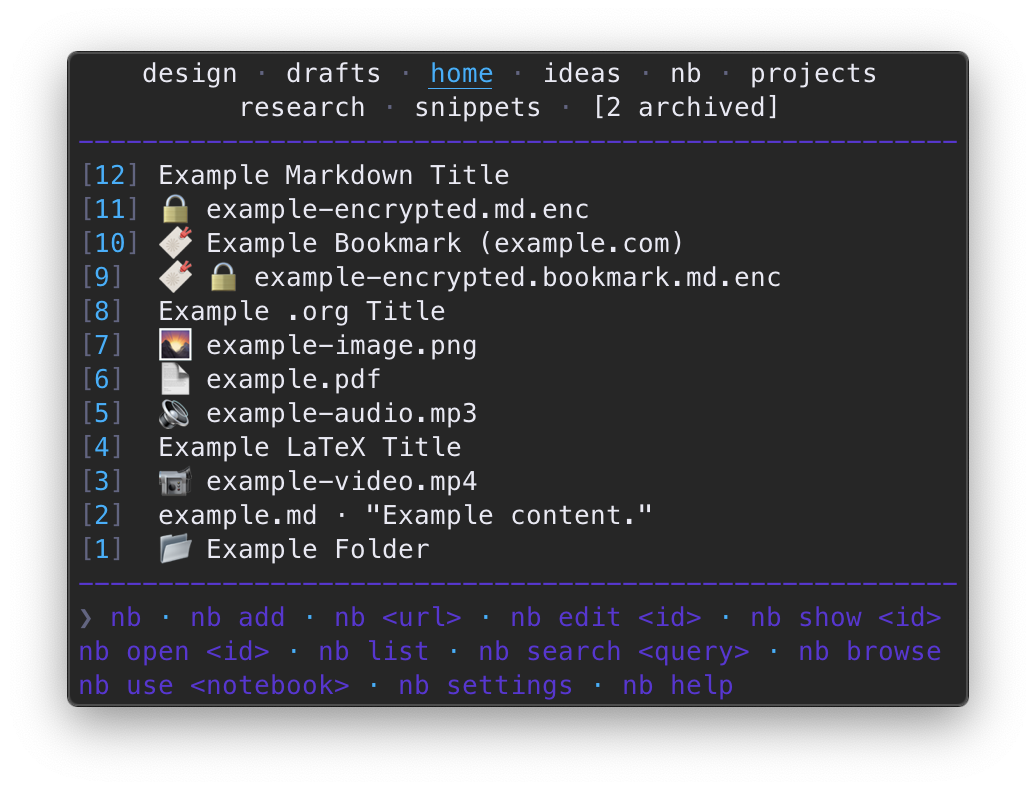 |
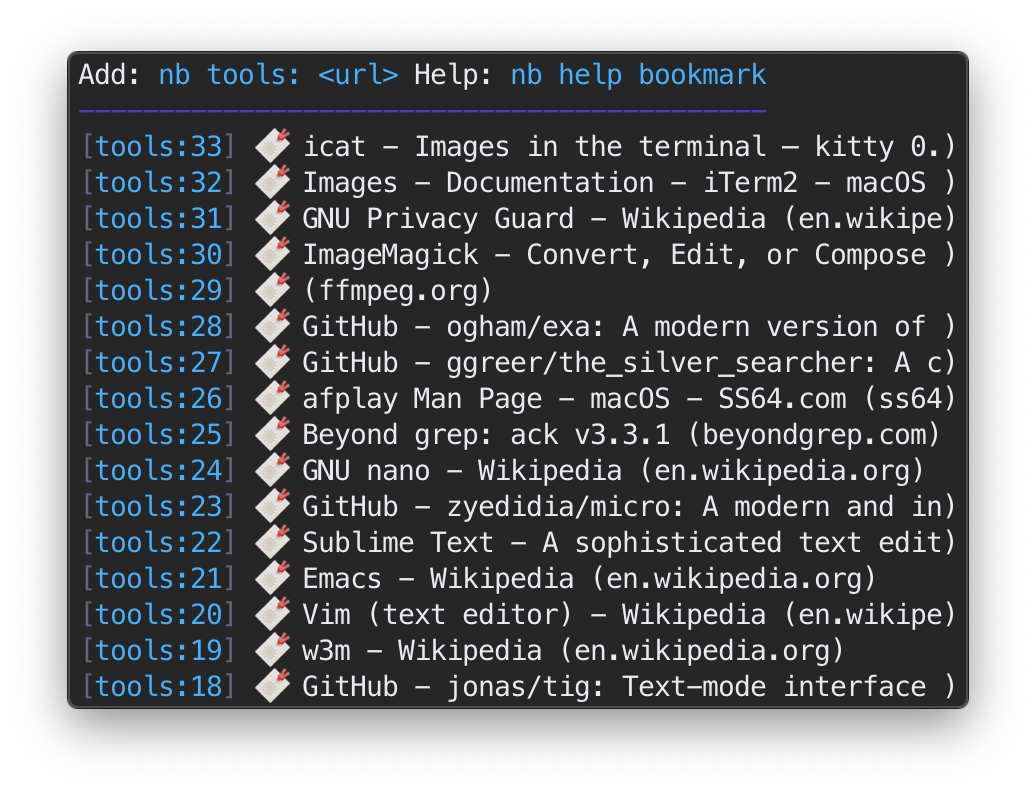 |
|---|---|
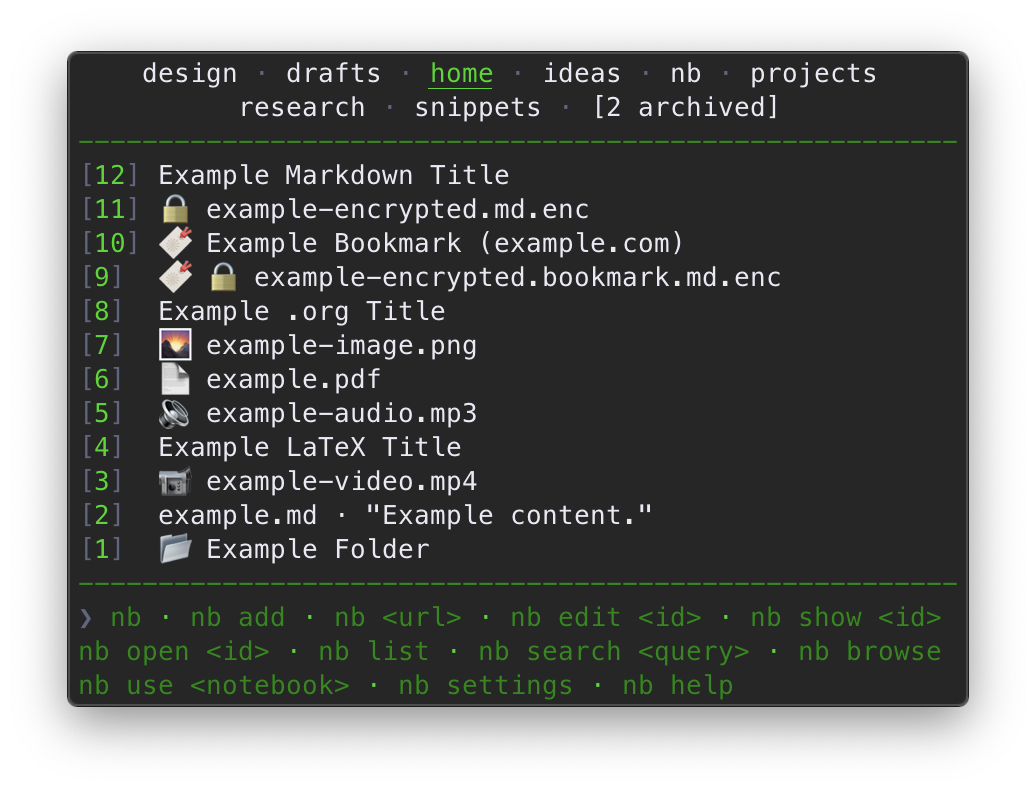 |
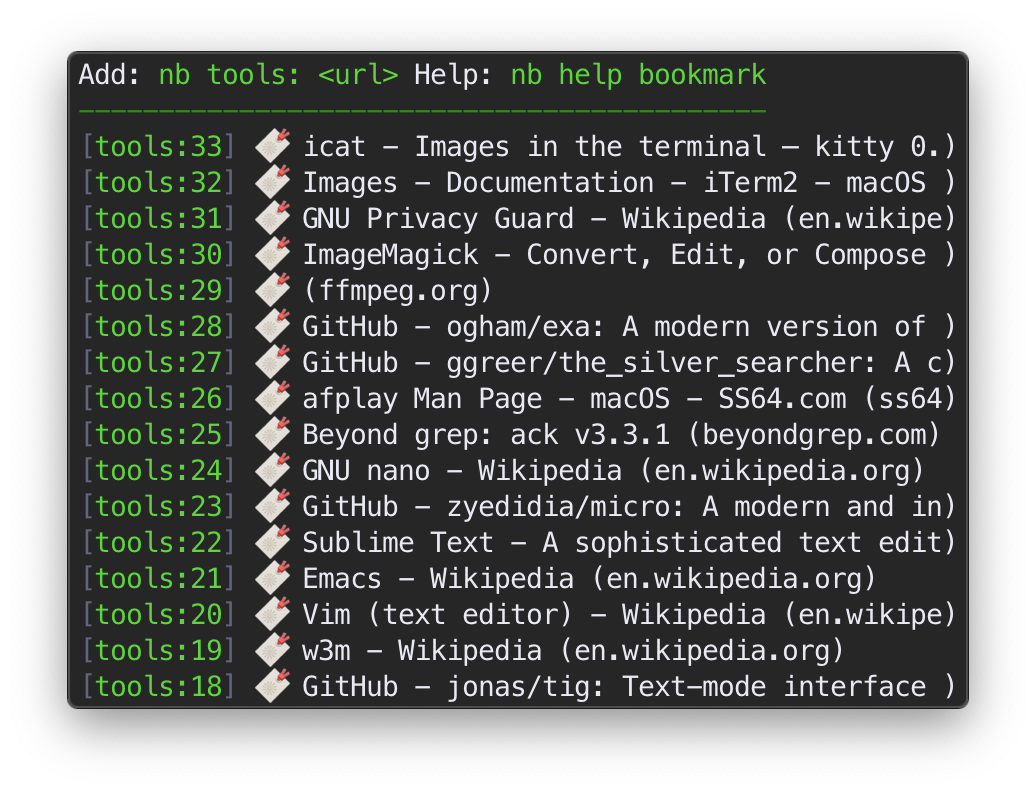 |
|---|---|
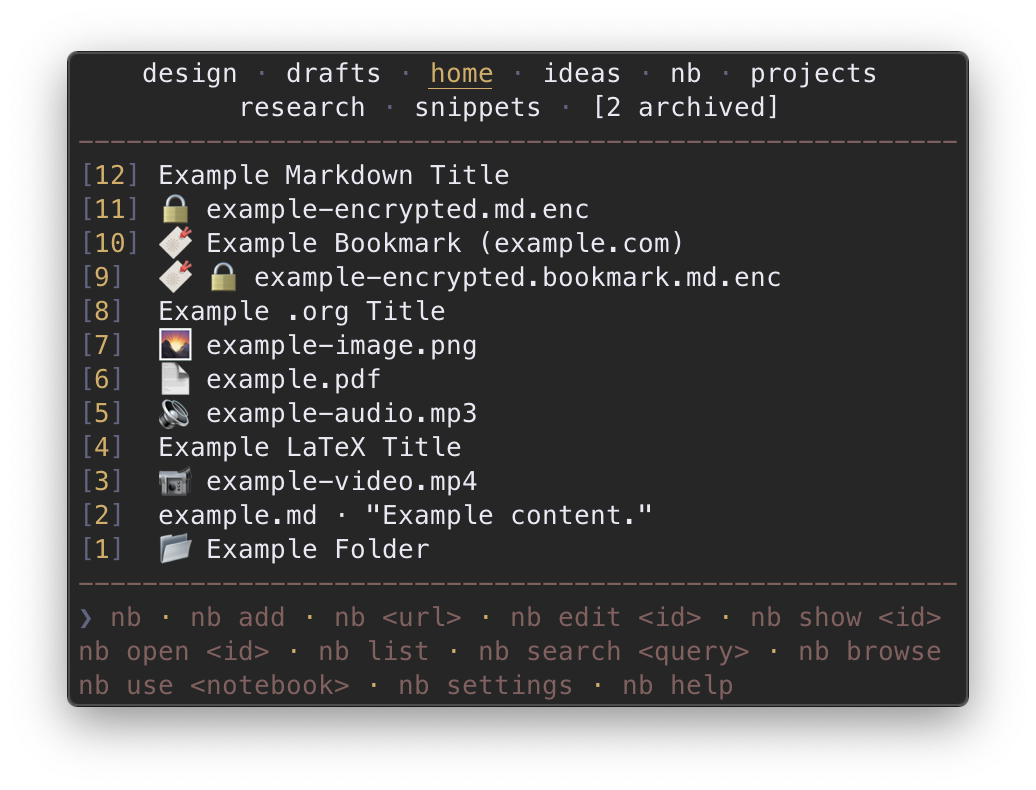 |
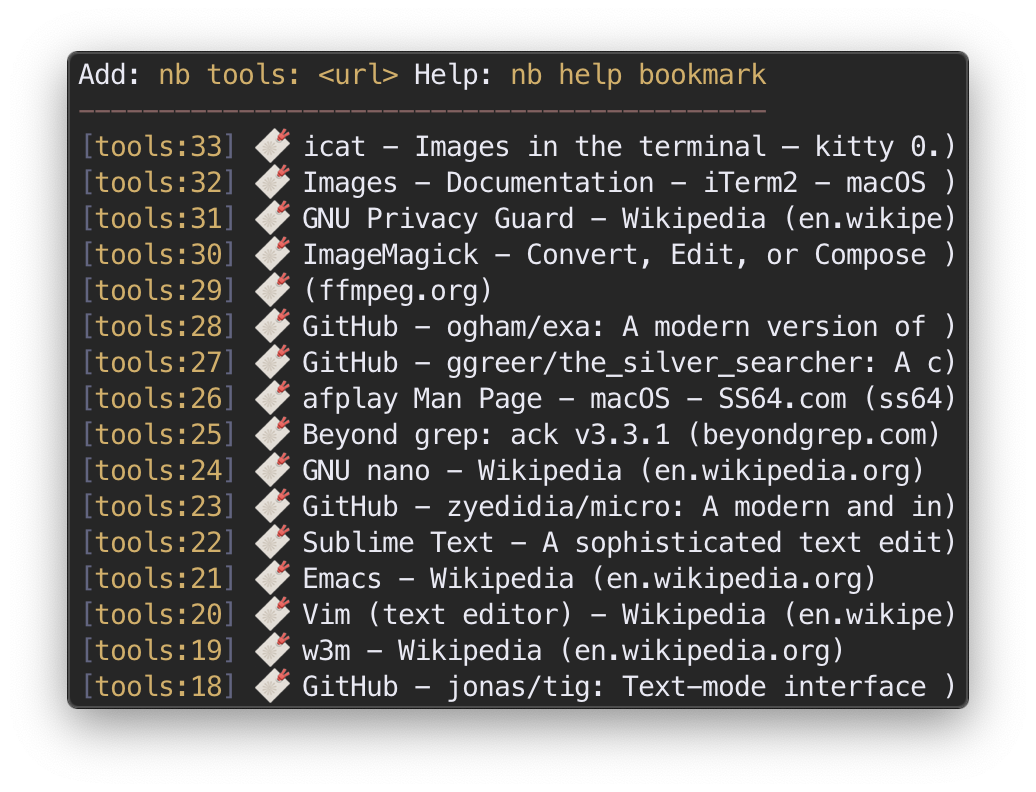 |
|---|---|
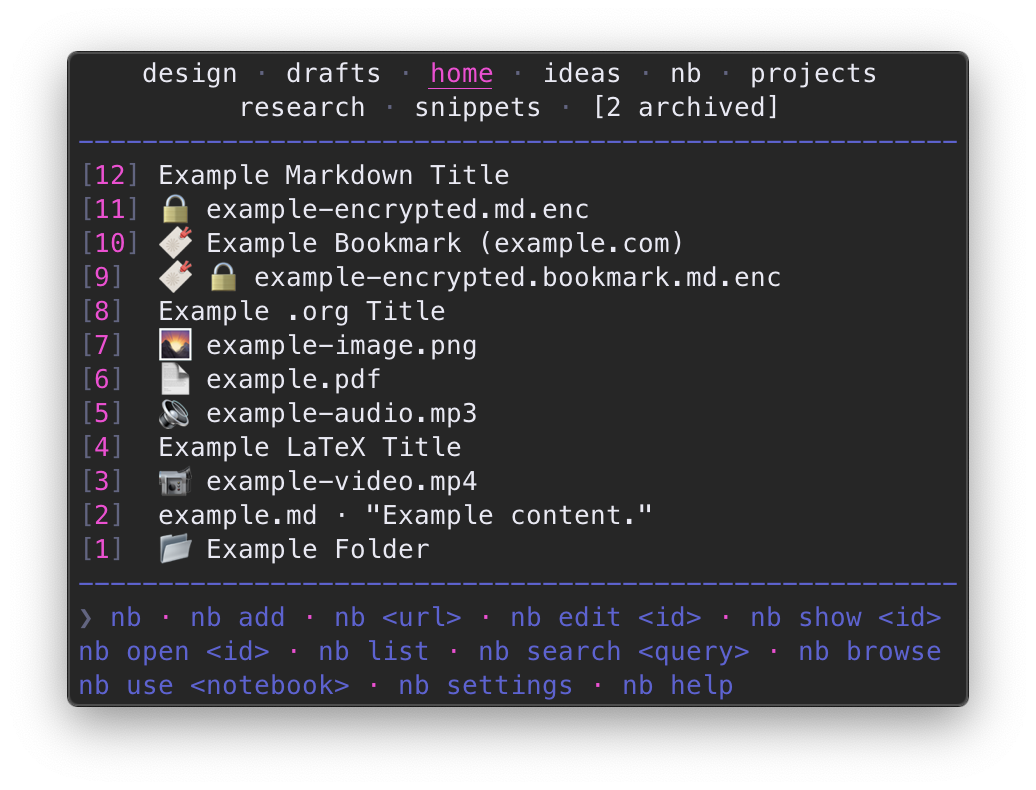 |
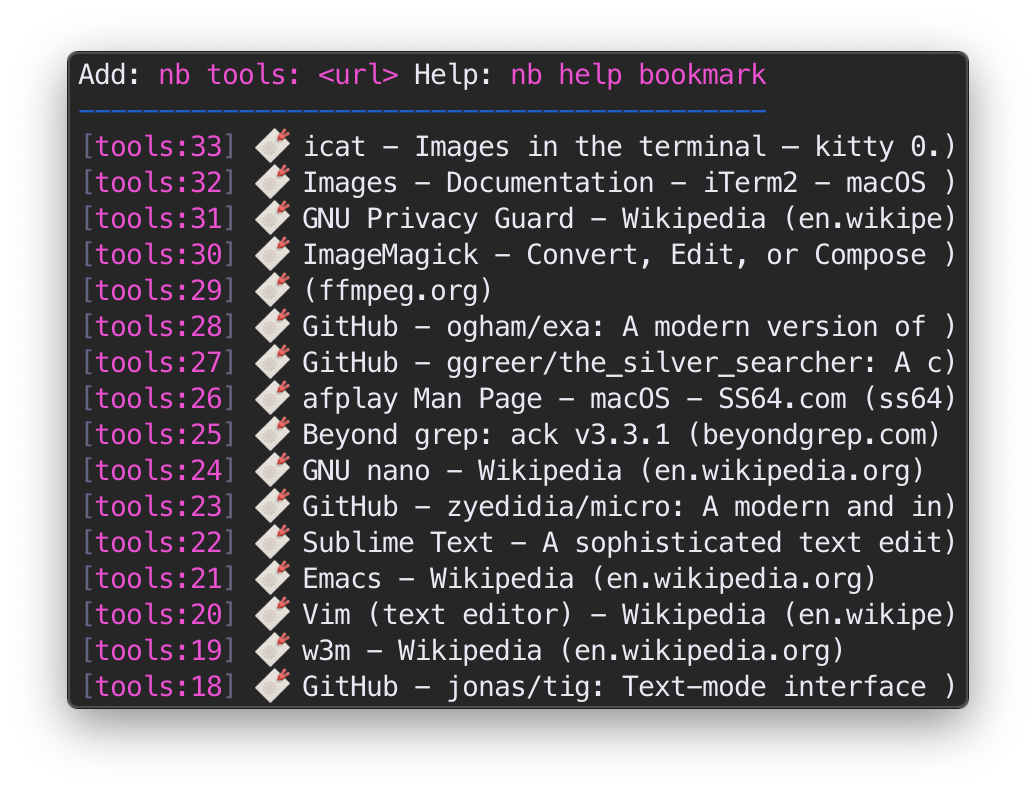 |
|---|---|
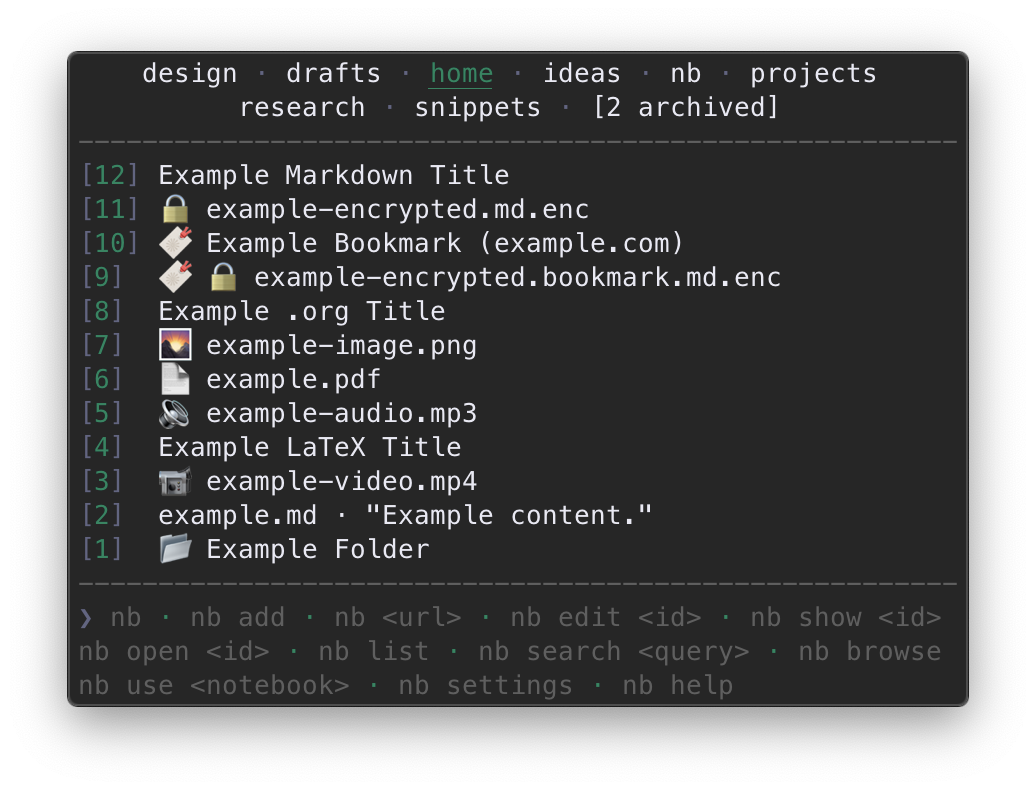 |
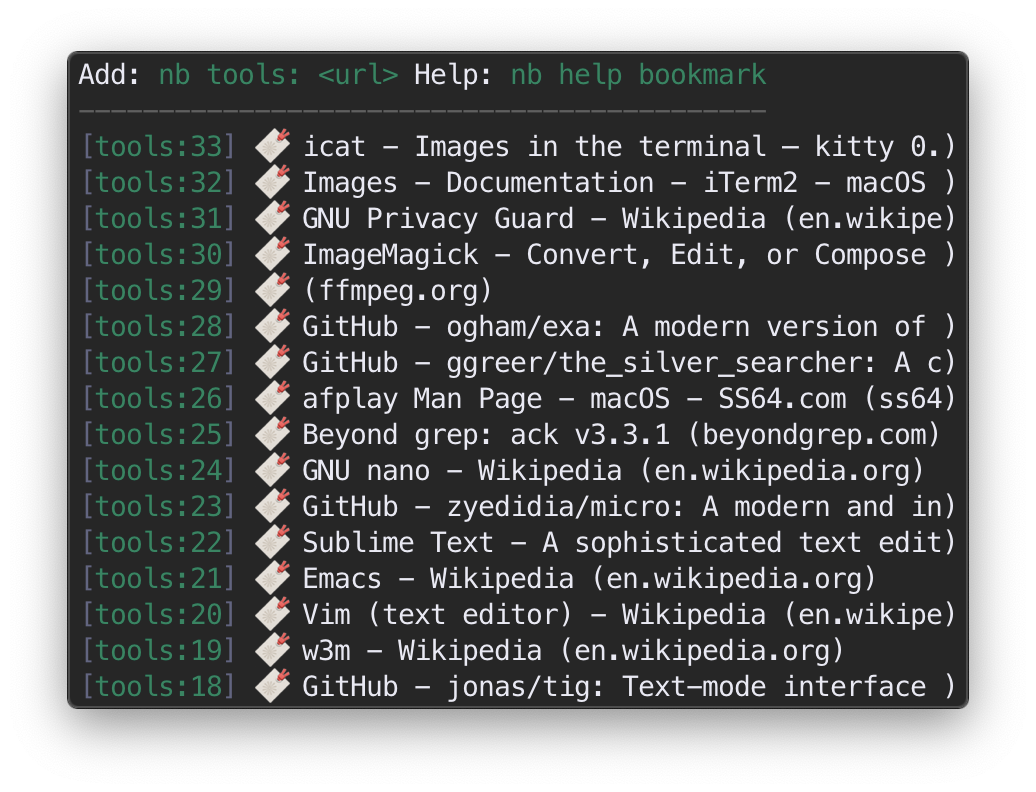 |
|---|---|
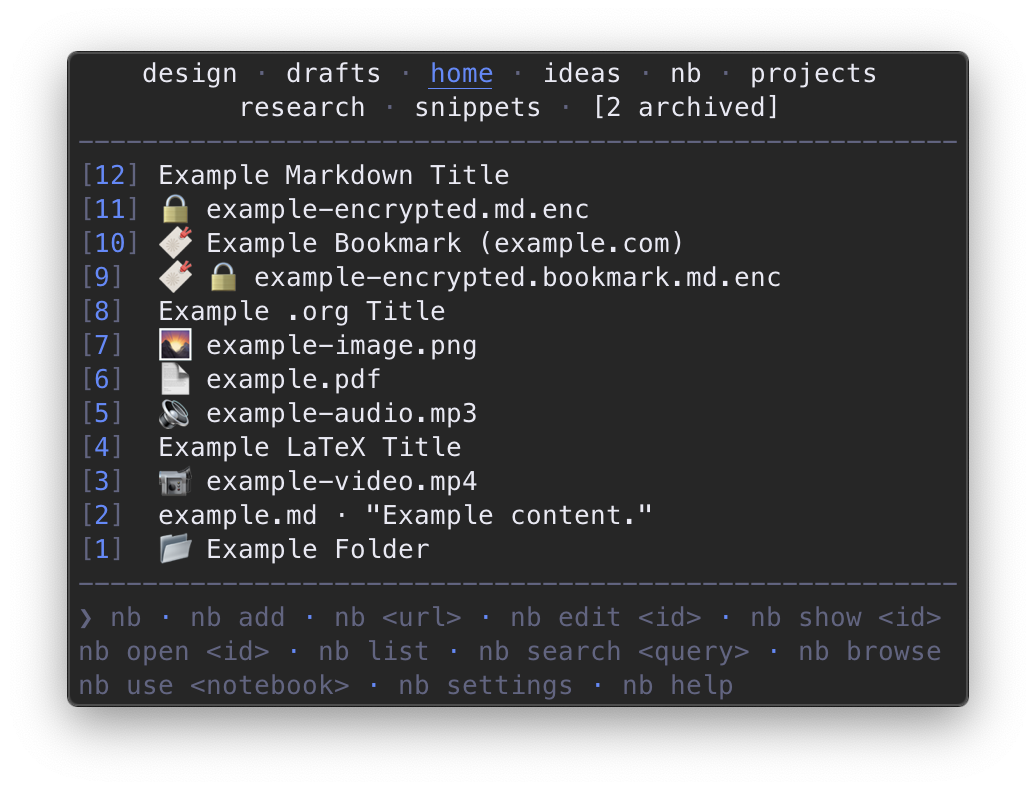 |
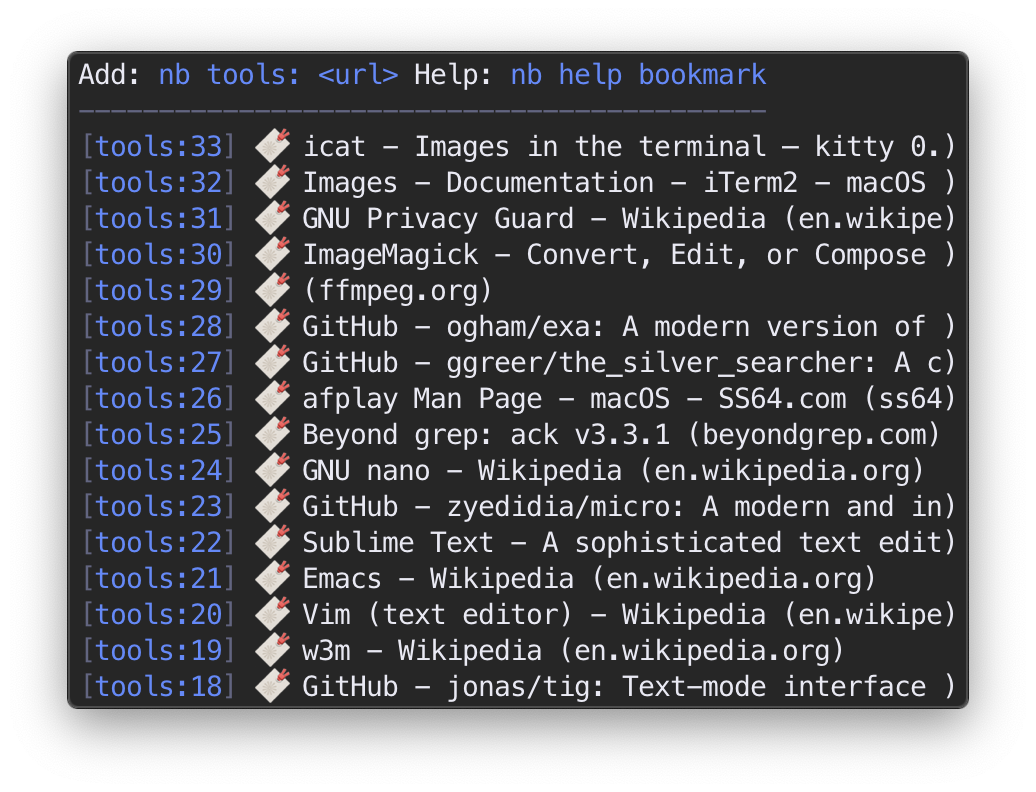 |
|---|---|
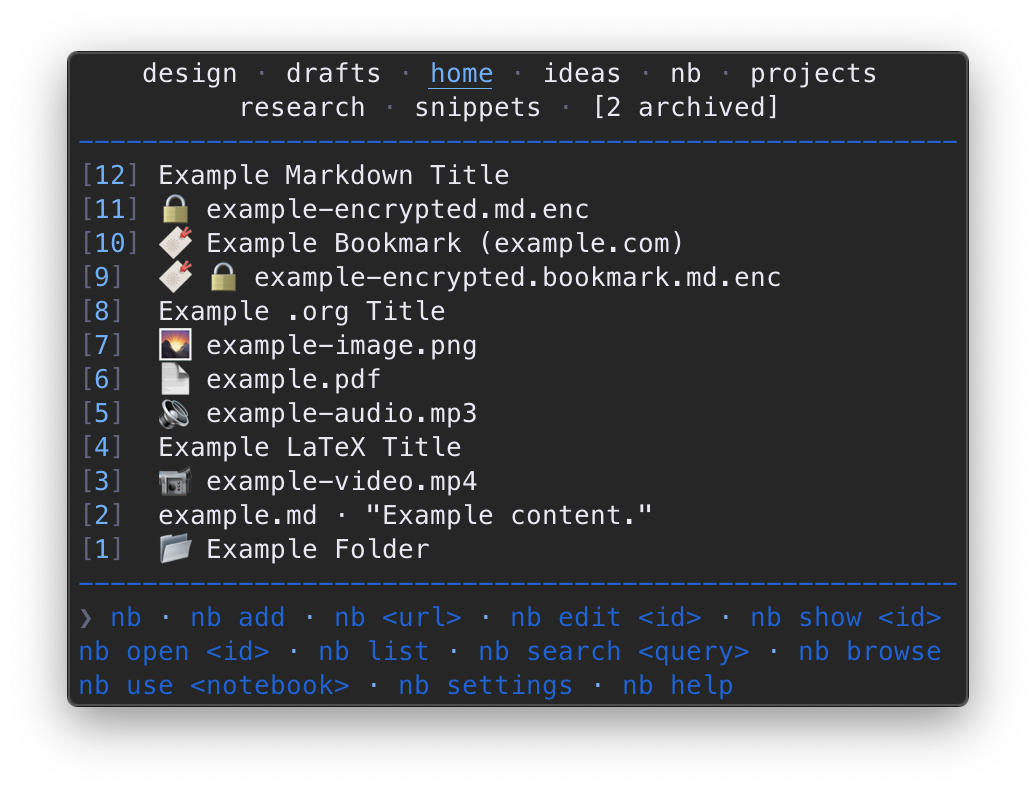 |
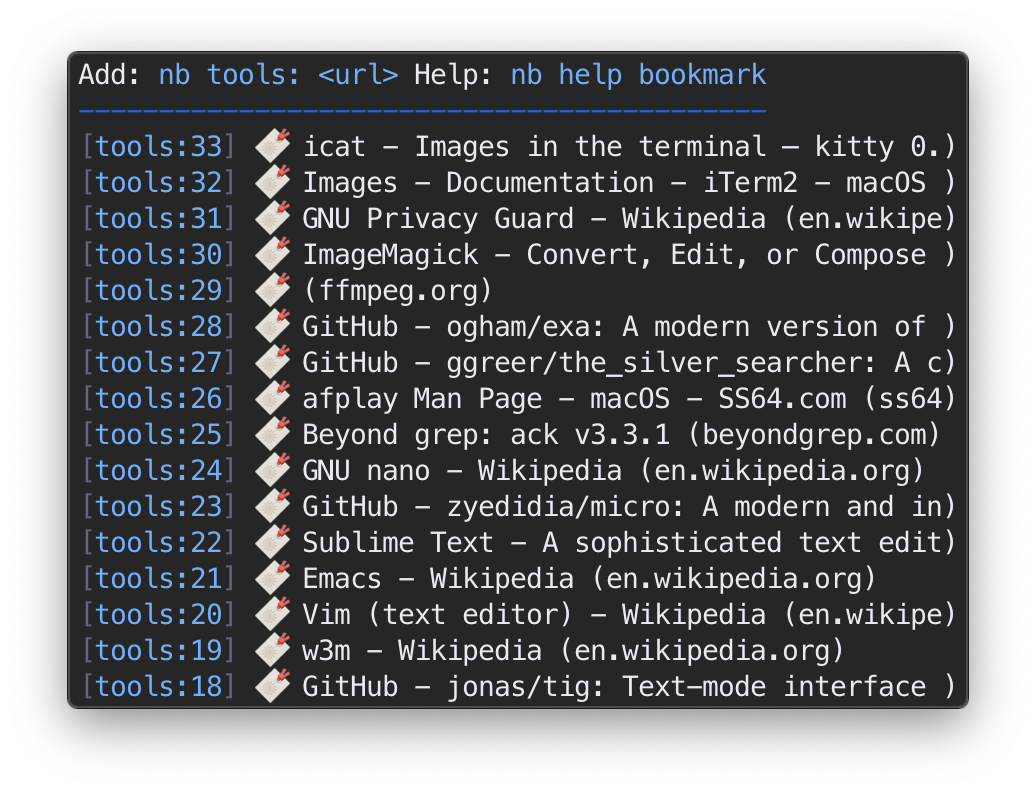 |
|---|---|
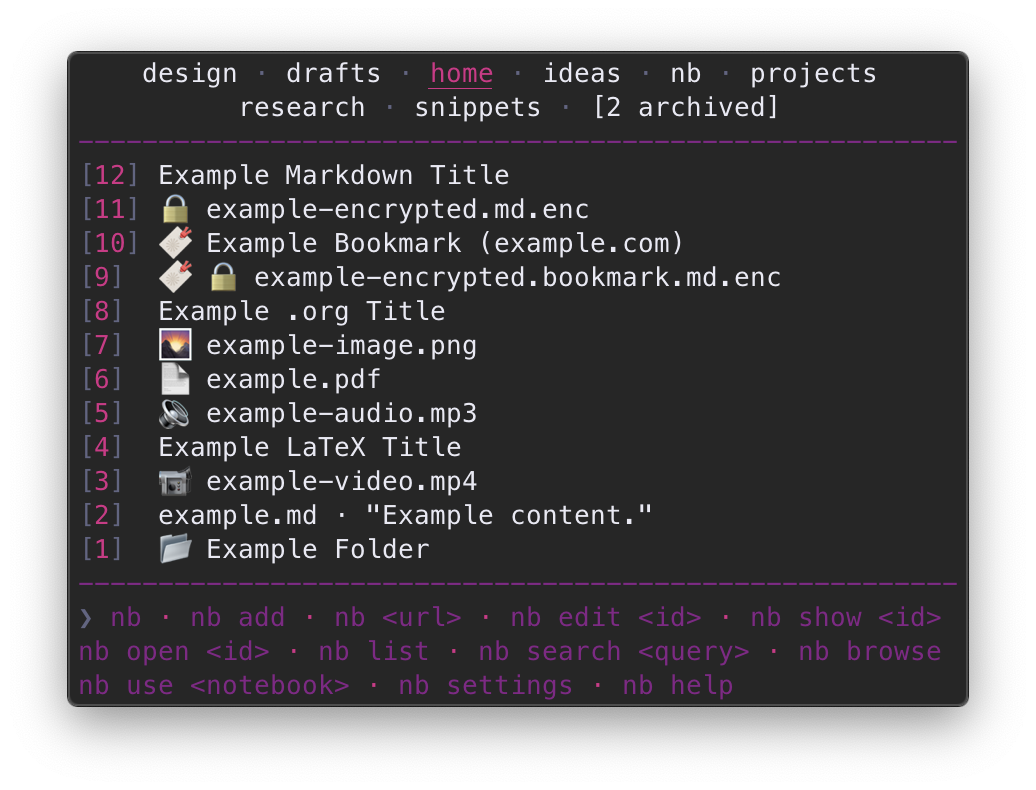 |
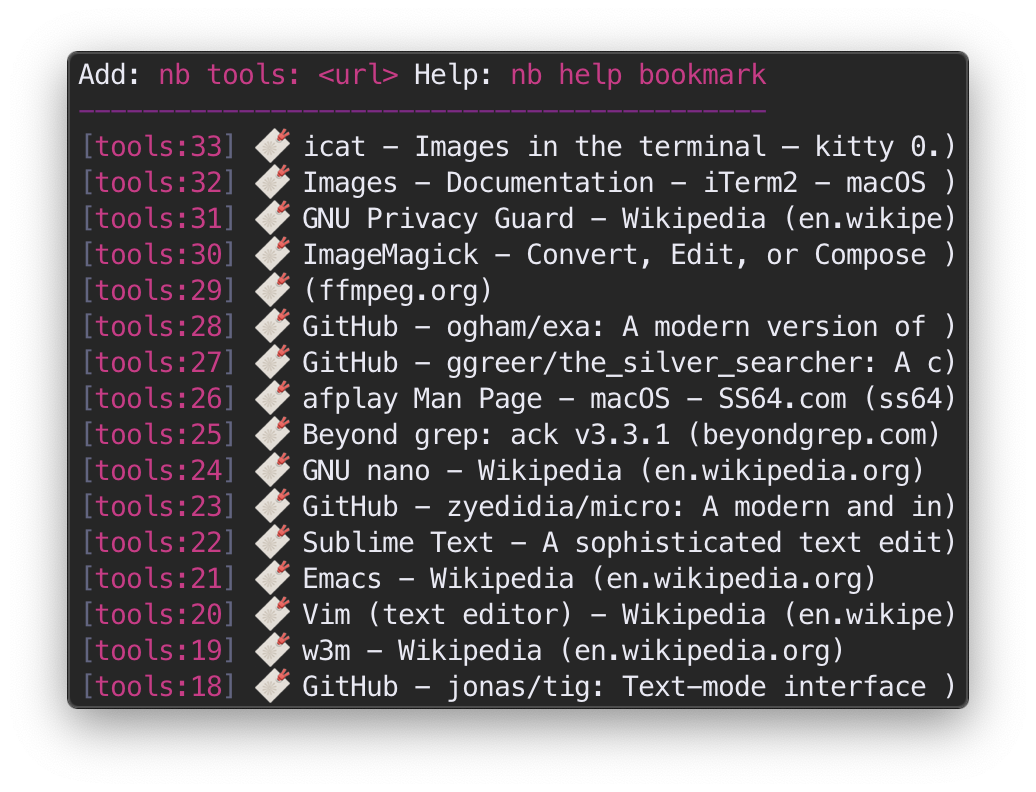 |
|---|---|
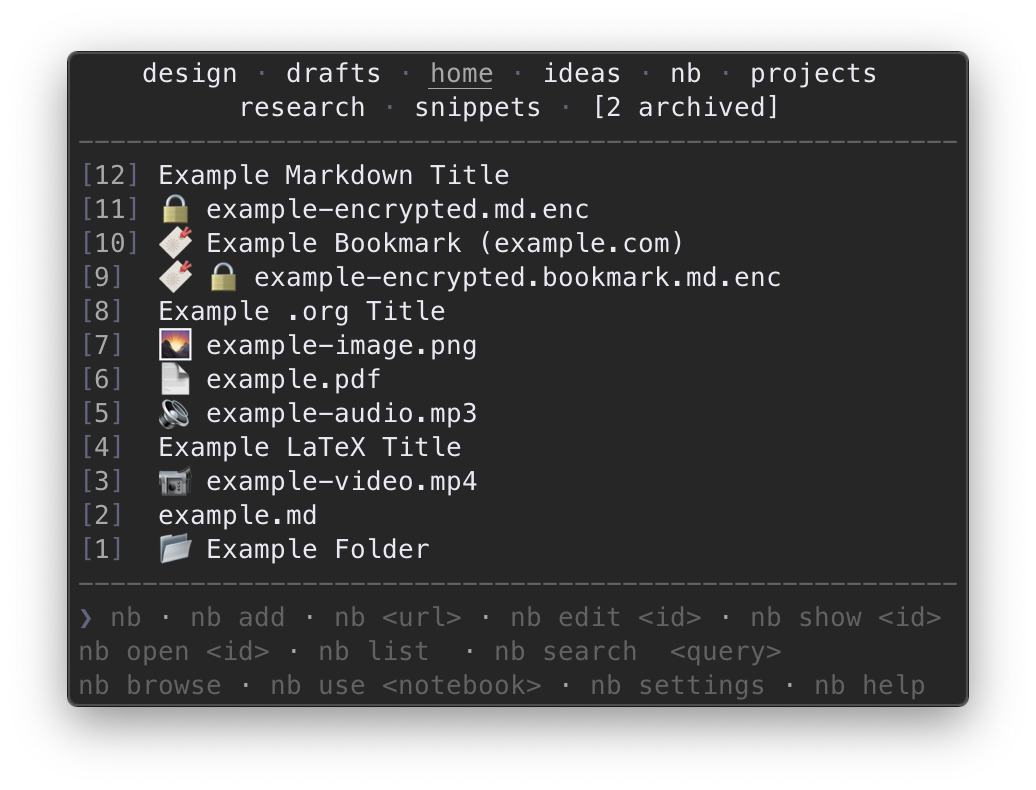 |
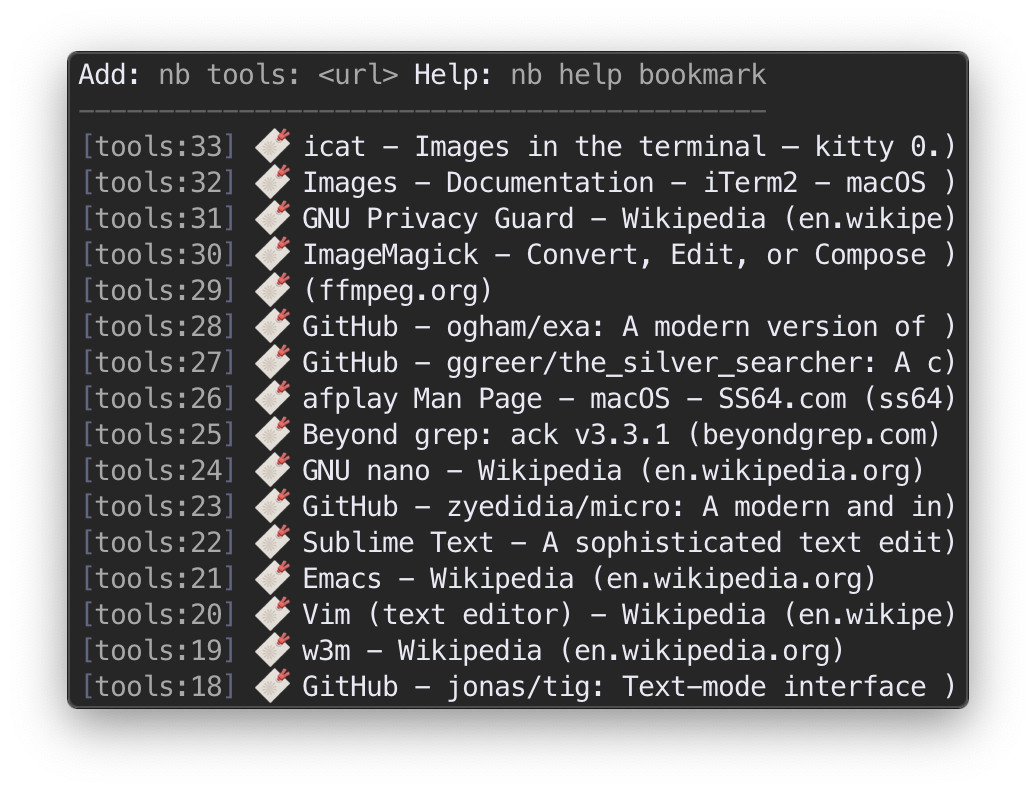 |
|---|---|
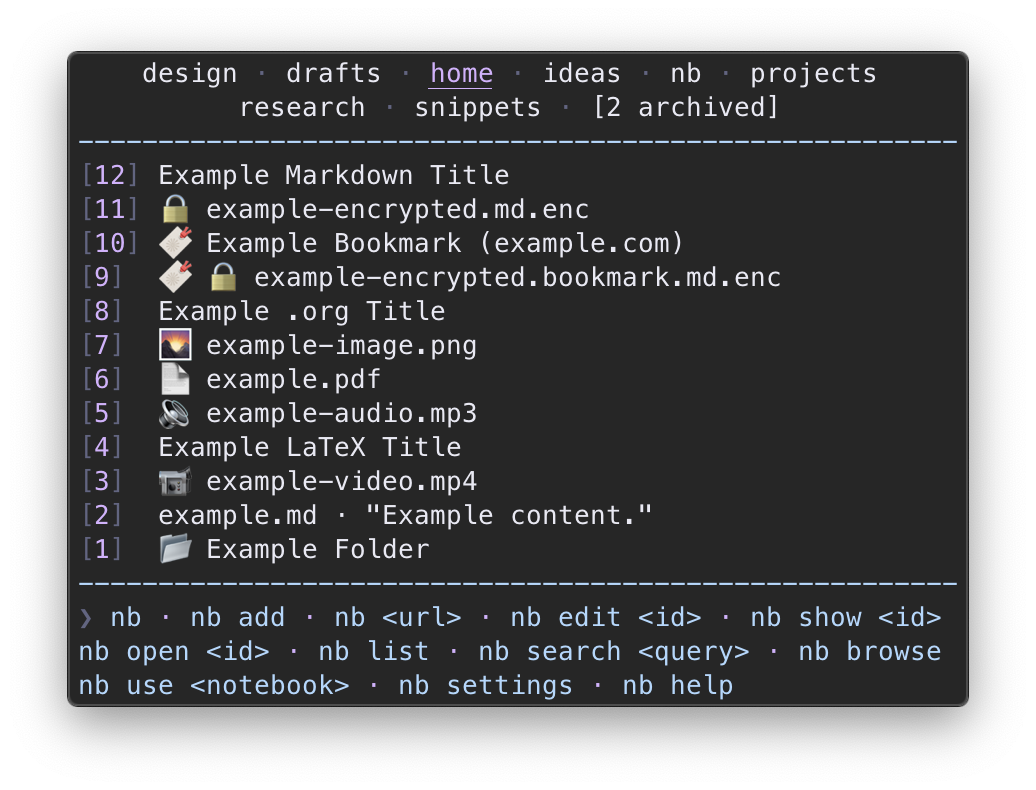 |
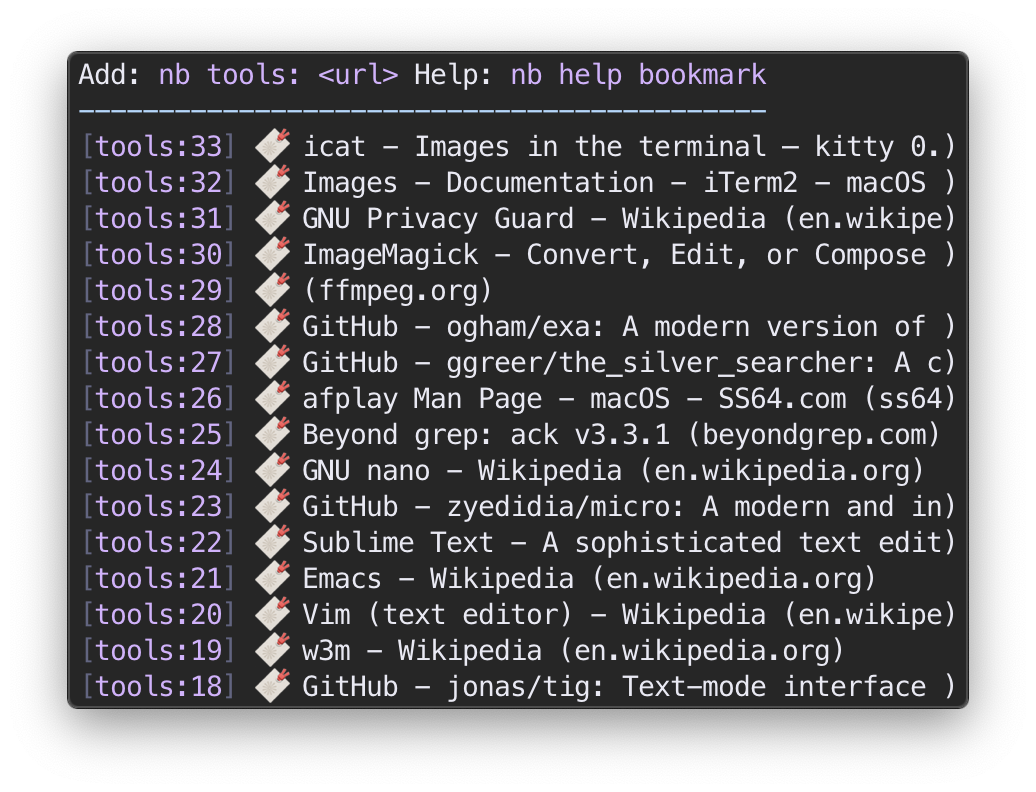 |
|---|---|
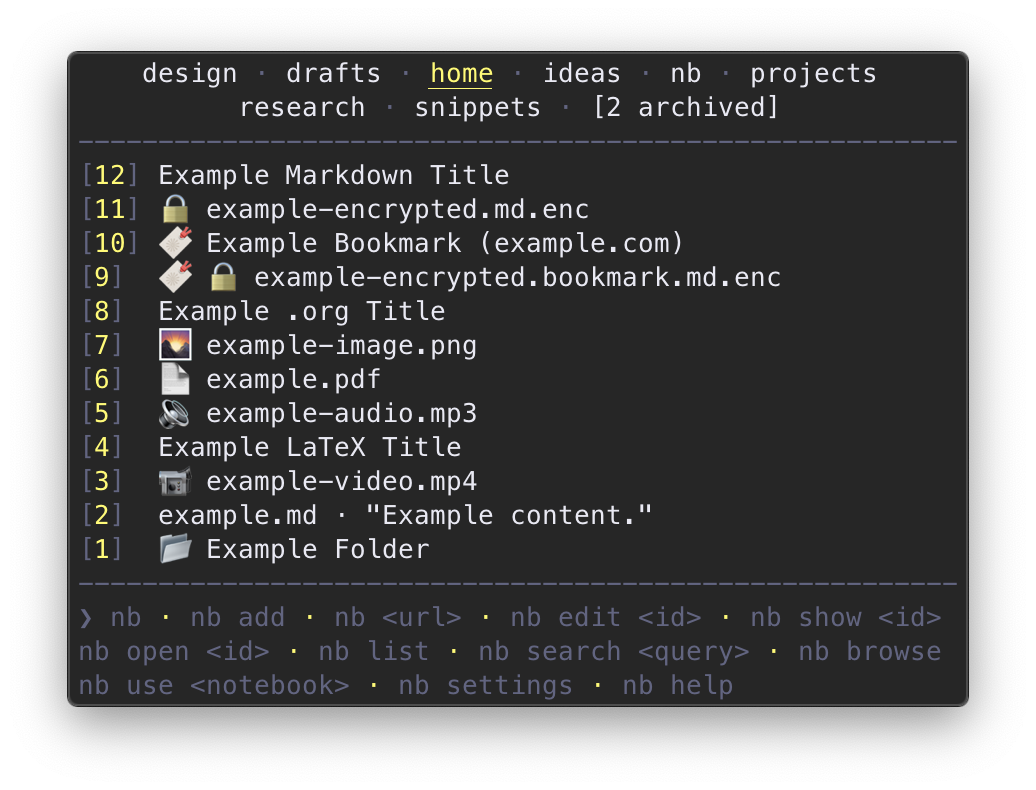 |
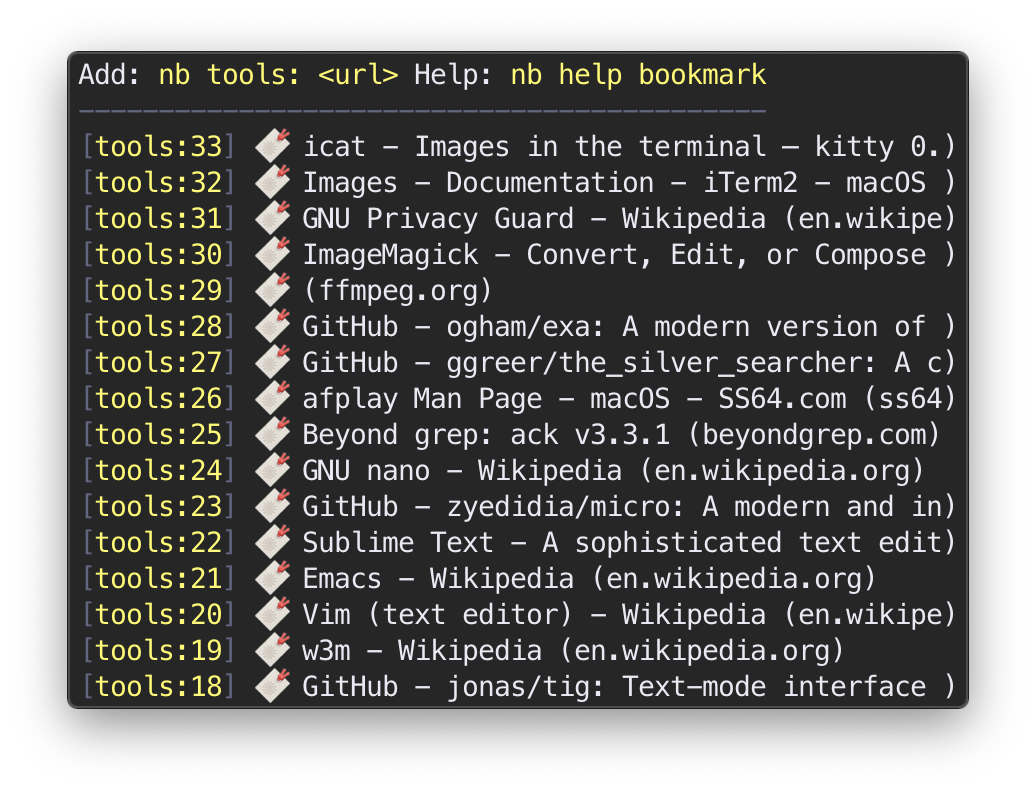 |
|---|---|
Color themes are nb plugins with a .nb-theme file
extension and contain one if statement indicating the name and setting
the color environment variables to tput ANSI color numbers:
# turquoise.nb-theme
if [[ "${NB_COLOR_THEME}" == "turquoise" ]]
then
export NB_COLOR_PRIMARY=43
export NB_COLOR_SECONDARY=38
fiView this theme as a complete file:
plugins/turquoise.nb-theme
Themes can be installed using nb plugins:
> nb plugins install https://github.com/xwmx/nb/blob/master/plugins/turquoise.nb-theme
Plugin installed:
/home/example/.nb/.plugins/turquoise.nb-themeOnce a theme is installed, use nb set color_theme to set it
as the current theme:
> nb set color_theme turquoise
NB_COLOR_THEME set to turquoiseThe primary and secondary colors can also be overridden individually, making color themes easily customizable:
# open the settings prompt for the primary color
nb set color_primary
# open the settings prompt for the secondary color
nb set color_secondaryTo view a table of available colors and numbers, run:
nb set colorsnb displays files with syntax highlighting when
bat,
highlight,
or
Pygments
is installed.
When bat is installed, syntax highlighting color themes are
available for both light and dark terminal backgrounds.
To view a list of available themes and set the syntax highlighting color
theme, use nb set syntax_theme.
astralZsh Theme - Displays the current notebook name in the context line of the prompt.
nb includes support for plugins, which can be used to create new
subcommands, design themes, and otherwise extend the functionality of nb.
nb supports two types of plugins, identified by their file extensions:
.nb-theme- Plugins defining color themes.
.nb-plugin- Plugins defining new subcommands and adding functionality.
Plugins are managed with the nb plugins subcommand and
are installed in the ${NB_DIR}/.plugins directory.
Plugins can be installed from either a URL or a path using the
nb plugins install subcommand.
# install a plugin from a URL
nb plugins install https://raw.githubusercontent.com/xwmx/nb/master/plugins/copy.nb-plugin
# install a plugin from a standard GitHub URL
nb plugins install https://github.com/xwmx/nb/blob/master/plugins/example.nb-plugin
# install a theme from a standard GitHub URL
nb plugins install https://github.com/xwmx/nb/blob/master/plugins/turquoise.nb-theme
# install a plugin from a path
nb plugins install plugins/example.nb-pluginThe <url> should be the full URL to the plugin file. nb also
recognizes regular GitHub URLs, which can be used interchangably with
raw GitHub URLs.
Installed plugins can be listed with nb plugins, which
optionally takes a name and prints full paths:
> nb plugins
copy.nb-plugin
example.nb-plugin
turquoise.nb-theme
> nb plugins copy.nb-plugin
copy.nb-plugin
> nb plugins --paths
/home/example/.nb/.plugins/copy.nb-plugin
/home/example/.nb/.plugins/example.nb-plugin
/home/example/.nb/.plugins/turquoise.nb-theme
> nb plugins turquoise.nb-theme --paths
/home/example/.nb/.plugins/turquoise.nb-themeUse nb plugins uninstall to uninstall a plugin:
> nb plugins uninstall example.nb-plugin
Plugin successfully uninstalled:
/home/example/.nb/.plugins/example.nb-pluginPlugins are written in a Bash-compatible shell scripting language and
have an .nb-plugin extension.
nb includes a few example plugins:
Create a new subcommand in three easy steps:
_subcommands add "example"_subcommands describe "example" <<HEREDOC
Usage:
nb example
Description:
Print "Hello, World!"
HEREDOC_example() {
printf "Hello, World!\\n"
}That's it! 🎉
View the complete plugin:
plugins/example.nb-plugin
With example.nb-plugin installed, nb includes an nb example subcommand
that prints "Hello, World!"
For a full example,
copy.nb-plugin
adds copy / duplicate functionality to nb and demonstrates how to create a
plugin using nb subcommands and simple shell scripting.
You can install any plugin you create locally with
nb plugins install <path>, and you can publish it on GitHub, GitLab, or
anywhere else online and install it with nb plugins install <url>.
The nb API is the command line interface, which is designed for
composability and provides a variety of powerful options for interacting with
notes, bookmarks, notebooks, and nb functionality. Within plugins,
subcommands can be called using their function names, which are named with
leading underscores. Options can be used to output information in formats
suitable for parsing and processing:
# print the content of note 3 to standard output with no color
_show 3 --print --no-color
# list all unarchived global notebook names
_notebooks --names --no-color --unarchived --global
# list all filenames in the current notebook
_list --filenames --no-id --no-indicator
# print the path to the current notebook
_notebooks current --pathItems in nb are primarily identified using structured arguments
that are referred to internally as "selectors". Selectors are like
addresses for notebooks, folders, and items. A selector can be as simple
as an id like 123 or folder path like example/, or it can combine
multiple elements to identify an item in a nested folder within a
particular notebook, such as
cli:tools/shellcheck/home-page.bookmark.md.
A selector is constructed by specifying the notebook name, folder path, and item identifier in the following pattern:
notebook:folder/path/item-idenitifer
Notebooks are identified by the notebook name followed by a colon. When no folder path or item identifer is specified, the command runs in the root folder of the notebook:
# list items in the "example" notebook
nb example:
# add a new note named "Example Title" to the "example" notebook
nb add example: --title "Example Title"
# edit item with id "123" in the notebook "example"
nb edit example:123A notebook selector can also be combined with a subcommand name to run the command within the notebook:
# list all items in the "example" notebook and display excerpts
nb example:list -e
# edit item with id "123" in the "example" notebook
nb example:edit 123
# show the git history for the notebook named "example"
nb example:historyFolders are identified by relative path from the notebook root, using either names or ids:
# list items in the folder named "sample" in the folder named demo"
nb sample/demo/
# add a new item to the folder named "demo" in the folder with id "3"
nb add 3/demo/
# show the history of the folder with id "4" in the folder named
# "sample" in the notebook named "example"
nb history example:sample/4/A trailing slash indicates that the command is expected to operate on the contents of the folder. When a trailing slash is omitted, the selector refers to the folder itself:
> nb list sample
[1] 📂 sample
> nb list sample/
[sample/3] Title Three
[sample/2] Title Two
[sample/1] Title OneFor more information about folders, see Folders.
An item is identified by id, filename, or title, optionally preceeded by notebook name or folder path:
# edit item with id "123"
nb edit 123
# open the item titled "demo title" in the folder with id "3"
nb open 3/demo\ title
# show "file.md" in the "sample" folder in the "example" notebook
nb show example:sample/file.mdItems can also be specified using the full path:
# edit "demo.md" in the "sample" folder in the "home" notebook
nb edit /home/example/.nb/home/sample/demo.mdIdenitifer Selectors
123
example.md
title
relative/path/to/123
relative/path/to/demo.md
relative/path/to/title
/full/path/to/sample.md
notebook:123
notebook:example.md
notebook:title
notebook:relative/path/to/123
notebook:relative/path/to/demo.md
notebook:relative/path/to/title
Subcommand Selectors
notebook:
notebook:show
notebook:history
notebook:a
notebook:q
nb automatically scans arguments for selectors with notebook names and
updates the current notebook if a valid one is found.
Identifier selectors are passed to subcommands as arguments along with
any subcommand options. Use show <selector> to query
information about the file specified in the selector. For example, to
obtain the filename of a selector-specified file, use
show <selector> --filename:
_example() {
local _selector="${1:-}"
[[ -z "${_selector:-}" ]] && printf "Usage: example <selector>\\n" && exit 1
# Get the filename using the selector.
local _filename
_filename="$(_show "${_selector}" --filename)"
# Rest of subcommand function...
}notebooks current --path returns the path to the current
notebook:
# _example() continued:
# get the notebook path
local _notebook_path
_notebook_path="$(_notebooks current --path)"
# print the file at "${_notebook_path}/${_filename}" to standard output
cat "${_notebook_path}/${_filename}"See
copy.nb-plugin
for a practical example using both show <selector> --filename and
notebooks current --path along with other
subcommands called using their underscore-prefixed function names.
Metadata in nb is primarily derived from git, the filesystem, and file
content, treating git and the filesystem like overlapping document databases.
For example, displayed timestamps are derived from
git log, with nb show --added
displaying the datetime of the first commit containing the file and
nb show --updated displaying the datetime of the last commit in
which the file was modified.
nb also uses plain-text files to store ids and state information in
git, including
.index files,
.pindex files,
and .archived files.
User-defined metadata can be added to notes in nb using "front
matter". Front matter is a
simple, human accessible, and future-proof method for defining metadata
fields in plain text and is well supported in tools for working with
Markdown.
Front matter is defined within a Markdown file with triple-dashed lines
(---) indicating the start and end of the block, with each field represented
by a key name with a colon followed by the value:
---
title: Example Title
author: xwmx
year: 2021
---
Example content.
More example content:
- one
- two
- threeAny metadata can be placed in the front matter block. nb uses the
title: field for listing, filtering, and selecting items, if one is
present, and ignores any other fields.
The simple key: value syntax is suitable for many metadata fields.
More complex data can be defined using additional
YAML
capabilities.
nb has an interactive shell that can be started with
nb shell, nb -i, or nb --interactive:
$ nb shell
__ _
\ \ _ __ | |__
\ \ | '_ \| '_ \
/ / | | | | |_) |
/_/ |_| |_|_.__/
------------------
nb shell started. Enter ls to list notes and notebooks.
Enter help for usage information. Enter exit to exit.
nb> ls
home
----
[3] Example
[2] Sample
[1] Demo
nb> edit 3 --content "New content."
Updated: [3] Example
nb> bookmark https://example.com
Added: [4] 🔖 example.bookmark.md "Example Title (example.com)"
nb> ls
home
----
[4] 🔖 Example Title (example.com)
[3] Example
[2] Sample
[1] Demo
nb> bookmark url 4
https://example.com
nb> search "example"
[4] example.bookmark.md "Example (example.com)"
-----------------------------------------------
1:# Example (example.com)
3:<https://example.com>
[3] example.md "Example"
------------------------
1:# Example
nb> exit
$The nb shell recognizes all nb subcommands and options,
providing a streamlined, distraction-free approach for working with nb.
Several core nb subcommands have single-character aliases to make
them faster to work with:
# `a` (add): add a new note named "example.md"
nb a example.md
# `b` (bookmark): list bookmarks
nb b
# `o` (open): open bookmark 12 in your web browser
nb o 12
# `p` (peek): open bookmark 6 in your terminal browser
nb p 6
# `e` (edit): edit note 5
nb e 5
# `d` (delete): delete note 19
nb d 19
# `s` (show): show note 27
nb s 27
# `q` (search): search notes for "example query"
nb q "example query"
# `h` (help): display the help information for the `add` subcommand
nb h add
# `u` (use): switch to example-notebook
nb u example-notebookFor more commands and options, run nb help or nb help <subcommand>
nb • bookmark • subcommands • plugins
__ _
\ \ _ __ | |__
\ \ | '_ \| '_ \
/ / | | | | |_) |
/_/ |_| |_|_.__/
[nb] Command line note-taking, bookmarking, archiving with plain-text data
storage, encryption, filtering and search, Git-backed versioning and syncing,
Pandoc-backed conversion, global and local notebooks, customizable color
themes, plugins, and more in a single portable, user-friendly script.
Help:
nb help Display this help information.
nb help <subcommand> View help information for <subcommand>.
nb help --colors View information about color settings.
nb help --readme View the `nb` README file.
Usage:
nb
nb [<ls options>...] [<id> | <filename> | <path> | <title> | <notebook>]
nb [<url>] [<bookmark options>...]
nb add [<notebook>:][<filename> | <folder-path> | <content>]
[-c <content> | --content <content>] [--edit] [-e | --encrypt]
[-f <filename> | --filename <filename>] [--folder <folder-path>]
[--tags <tag1>,<tag2>...] [-t <title> | --title <title>]
[--type <type>]
nb add folder [<name>]
nb bookmark [<ls options>...]
nb bookmark <url> [-c <comment> | --comment <comment>] [--edit]
[-e | --encrypt] [-f <filename> | --filename <filename>]
[-q | --quote] [-r <url> | --related <url>]... [--save-source]
[--skip-content] [-t <tag1>,<tag2>... | --tags <tag1>,<tag2>...]
[--title <title>]
nb bookmark [list [<list-options>...]]
nb bookmark (open | peek | url) (<id> | <filename> | <path> | <title>)
nb bookmark (edit | delete) (<id> | <filename> | <path> | <title>)
nb bookmark search <query>
nb browse [<notebook>:][<id> | <filename> | <title> | <path>]
[-e | --edit] [-g | --gui] [--notebooks] [--print]
[-q | --query <query>] [-s | --serve]
nb completions (check | install [-d | --download] | uninstall)
nb count [<notebook>:][<relative-path>]
nb delete [<notebook>:](<id> | <filename> | <path> | <title>)...
[-f | --force]
nb edit (<id> | <filename> | <path> | <title>)
[-c <content> | --content <content>] [--edit]
[-e <editor> | --editor <editor>] [--overwrite] [--prepend]
nb export (<id> | <filename> | <path> | <title>) <path> [-f | --force]
[<pandoc options>...]
nb export notebook <name> [<path>]
nb export pandoc (<id> | <filename> | <path> | <title>)
[<pandoc options>...]
nb git [checkpoint [<message>] | dirty]
nb git <git-options>...
nb help [<subcommand>] [-p | --print]
nb help [-c | --colors] | [-r | --readme] | [-s | --short] [-p | --print]
nb history [<id> | <filename> | <path> | <title>]
nb import [copy | download | move] (<path>... | <url>) [--convert]
nb import notebook <path> [<name>]
nb init [<remote-url>]
nb list [-e [<length>] | --excerpt [<length>]] [--filenames]
[-n <limit> | --limit <limit> | --<limit>] [--no-id]
[--no-indicator] [-p | --pager] [--paths] [-s | --sort]
[-r | --reverse] [-t <type> | --type <type> | --<type>]
[<id> | <filename> | <path> | <title> | <query>]
nb ls [-a | --all] [-e [<length>] | --excerpt [<length>]] [--filenames]
[-n <limit> | --limit <limit> | --<limit>] [--no-footer] [--no-header]
[--no-id] [--no-indicator] [-p | --pager] [--paths] [-s | --sort]
[-r | --reverse] [-t <type> | --type <type> | --<type>]
[<id> | <filename> | <path> | <title> | <query>]
nb move [<notebook>:](<id> | <filename> | <path> | <title>) [-f | --force]
([<notebook>:][<path>] | --reset | --to-bookmark | --to-note)
nb notebooks [<name>] [--archived] [--global] [--local] [--names]
[--paths] [--unarchived]
nb notebooks add <name> [<remote-url>]
nb notebooks (archive | open | peek | status | unarchive) [<name>]
nb notebooks current [--path | --selected | --filename [<filename>]]
[--global | --local]
nb notebooks delete <name> [-f | --force]
nb notebooks (export <name> [<path>] | import <path>)
nb notebooks init [<path> [<remote-url>]]
nb notebooks rename <old-name> <new-name>
nb notebooks select <selector>
nb notebooks show (<name> | <path> | <selector>) [--archived]
[--escaped | --name | --path | --filename [<filename>]]
nb notebooks use <name>
nb open (<id> | <filename> | <path> | <title> | <notebook>)
nb peek (<id> | <filename> | <path> | <title> | <notebook>)
nb pin [<notebook>:](<id> | <filename> | <path> | <title>)
nb plugins [<name>] [--paths]
nb plugins install [<path> | <url>] [--force]
nb plugins uninstall <name> [--force]
nb remote [remove | set <url> [-f | --force]]
nb run <command> [<arguments>...]
nb search <query>... [-a | --all] [--and <query>] [--or <query>]
[-l | --list] [--path] [-t <type> | --type <type> | --<type>]
[--utility <name>]
nb set [<name> [<value>] | <number> [<value>]]
nb settings [colors [<number> | themes] | edit | list [--long]]
nb settings (get | show | unset) (<name> | <number>)
nb settings set (<name> | <number>) <value>
nb shell [<subcommand> [<options>...] | --clear-history]
nb show [<notebook>:](<id> | <filename> | <path> | <title>)
[[-a | --added] | [-b | --browse] | --filename | --id | --info-line |
--path | [-p | --print] [-r | --render] | --title | --type [<type>] |
[-u | --updated]] [--no-color]
nb show <notebook>
nb subcommands [add <name>...] [alias <name> <alias>]
[describe <name> <usage>]
nb sync [-a | --all]
nb unpin [<notebook>:](<id> | <filename> | <path> | <title>)
nb update
nb use <notebook>
nb -i | --interactive [<subcommand> [<options>...]]
nb -h | --help | help [<subcommand> | --readme]
nb --no-color
nb --version | version
Subcommands:
(default) List notes and notebooks. This is an alias for `nb ls`.
When a <url> is provided, create a new bookmark.
add Add a note, folder, or file.
bookmark Add, open, list, and search bookmarks.
browse Browse, view, and edit linked items in terminal and GUI browsers.
completions Install and uninstall completion scripts.
count Print the number of items in a notebook or folder.
delete Delete a note.
edit Edit a note.
export Export a note to a variety of different formats.
git Run `git` commands within the current notebook.
help View help information for the program or a subcommand.
history View git history for the current notebook or a note.
import Import a file into the current notebook.
init Initialize the first notebook.
list List notes in the current notebook.
ls List notebooks and notes in the current notebook.
move Move or rename a note.
notebooks Manage notebooks.
open Open a bookmarked web page or notebook folder, or edit a note.
peek View a note, bookmarked web page, or notebook in the terminal.
pin Pin an item so it appears first in lists.
plugins Install and uninstall plugins and themes.
remote Get, set, and remove the remote URL for the notebook.
run Run shell commands within the current notebook.
search Search notes.
settings Edit configuration settings.
shell Start the `nb` interactive shell.
show Show a note or notebook.
status Run `git status` in the current notebook.
subcommands List, add, alias, and describe subcommands.
sync Sync local notebook with the remote repository.
unpin Unpin a pinned item.
update Update `nb` to the latest version.
use Switch to a notebook.
version Display version information.
Notebook Usage:
nb <notebook>:[<subcommand>] [<identifier>] [<options>...]
nb <subcommand> <notebook>:<identifier> [<options>...]
Program Options:
-i, --interactive Start the `nb` interactive shell.
-h, --help Display this help information.
--no-color Print without color highlighting.
--version Display version information.
More Information:
https://github.com/xwmx/nb
__ __ __
/ /_ ____ ____ / /______ ___ ____ ______/ /__
/ __ \/ __ \/ __ \/ //_/ __ `__ \/ __ `/ ___/ //_/
/ /_/ / /_/ / /_/ / ,< / / / / / / /_/ / / / ,<
/_.___/\____/\____/_/|_/_/ /_/ /_/\__,_/_/ /_/|_|
bookmark -- Command line bookmarking with tagging, encryption,
full-text page content search with regular expression support,
GUI and terminal browser support, and data stored in plain text
Markdown files with Git-backed versioning and syncing.
Usage:
bookmark [<ls options>...]
bookmark <url> [-c <comment> | --comment <comment>] [--edit]
[-e | --encrypt] [-f <filename> | --filename <filename>]
[-q | --quote] [-r <url> | --related <url>]... [--save-source]
[--skip-content] [-t <tag1>,<tag2>... | --tags <tag1>,<tag2>...]
[--title <title>]
bookmark list [<list-options>...]
bookmark (open | peek | url) (<id> | <filename> | <path> | <title>)
bookmark (edit | delete) (<id> | <filename> | <path> | <title>)
bookmark search <query>
Options:
-c, --comment <comment> A comment or description for this bookmark.
--edit Open the bookmark in your editor before saving.
-e, --encrypt Encrypt the bookmark with a password.
-f, --filename <filename> The filename for the bookmark. It is
recommended to omit the extension so the
default bookmark extension is used.
-q, --quote <quote> A quote or excerpt from the saved page.
Alias: `--excerpt`
-r, --related <url> A URL for a page related to the bookmarked page.
Multiple `--related` flags can be used in a
command to save multiple related URLs.
--save-source Save the page source as HTML.
--skip-content Omit page content from the note.
-t, --tags <tag1>,<tag2>... A comma-separated list of tags.
--title <title> The bookmark title. When not specified,
`nb` will use the html <title> tag.
Subcommands:
(default) Add a new bookmark for <url>, or list bookmarks.
Bookmarks can also be added with `nb <url>`
delete Delete a bookmark.
edit Edit a bookmark.
list List bookmarks in the current notebook.
Shortcut Alias: `ls`
open Open the bookmarked page in your system's primary web browser.
Shortcut Alias: `o`
peek Open the bookmarked page in your terminal web browser.
Alias: `preview`
Shortcut Alias: `p`
search Search bookmarks for <query>.
Shortcut Alias: `q`
url Print the URL for the specified bookmark.
Description:
Create, view, search, edit, and delete bookmarks.
By default, the html page content is saved within the bookmark, making the
bookmarked page available for full-text search. When Pandoc [1] is
installed, the HTML content will be converted to Markdown before saving.
When readability-cli [2] is install, markup is cleaned up to focus on
content.
`peek` opens the page in `w3m` [3] or `lynx` [4] when available.
To specify a preferred browser, set the `$BROWSER` environment variable
in your .bashrc, .zshrc, or equivalent, e.g., `export BROWSER="lynx"`.
Bookmarks are identified by the `.bookmark.md` file extension. The
bookmark URL is the first URL in the file within "<" and ">" characters:
<https://www.example.com>
1. https://pandoc.org/
2. https://gitlab.com/gardenappl/readability-cli
3. https://en.wikipedia.org/wiki/W3m
4. https://en.wikipedia.org/wiki/Lynx_(web_browser)
Examples:
bookmark https://example.com
bookmark https://example.com --encrypt
bookmark https://example.com --tags example,sample,demo
bookmark https://example.com/about -c "Example comment."
bookmark https://example.com/faqs -f example-filename
bookmark https://example.com --quote "Example quote or excerpt."
bookmark list
bookmark search "example query"
bookmark open 5
------------------------------------------
Part of `nb` (https://github.com/xwmx/nb).
For more information, see: `nb help`.
add • bookmark • browse • completions • count • delete • edit • env • export • git • help • history • import • init • list • ls • move • notebooks • open • peek • pin • plugins • remote • run • search • settings • shell • show • status • subcommands • sync • unpin • update • use • version
Usage:
nb add [<notebook>:][<filename> | <folder-path> | <content>]
[-c <content> | --content <content>] [--edit] [-e | --encrypt]
[-f <filename> | --filename <filename>] [--folder <folder-path>]
[--tags <tag1>,<tag2>...] [-t <title> | --title <title>]
[--type <type>]
nb add folder [<name>]
Options:
-c, --content <content> The content for the new note.
--edit Open the note in the editor before saving when
content is piped or passed as an argument.
-e, --encrypt Encrypt the note with a password.
-f, --filename <filename> The filename for the new note.
--folder <folder-path> Add within the folder located at <folder-path>.
--tags <tag1>,<tag2>.... A comma-separated list of tags.
-t, --title <title> The title for a new note. If `--title` is
present, the filename will be derived from the
title, unless `--filename` is specified.
--type <type> The file type for the new note, as a file
extension.
Description:
Create a new note or folder.
If no arguments are passed, a new blank note file is opened with
`$EDITOR`, currently set to "example". If a non-option argument is
passed, `nb` will treat it as a <filename≥ if a file extension is found.
If no file extension is found, `nb` will treat the string as
<content> and will create a new note without opening the editor.
`nb add` can also create a new note with piped content.
`nb` creates Markdown files by default. To create a note with a
different file type, use the extension in the filename or use the `--type`
option. To change the default file type, use `nb set default_extension`.
When the `-e` / `--encrypt` option is used, `nb` will encrypt the
note with AES-256 using OpenSSL by default, or GPG, if configured in
`nb set encryption_tool`.
Examples:
nb add
nb add example.md
nb add "Note content."
nb add example.md --title "Example Title" --content "Example content."
echo "Note content." | nb add
nb add -t "Secret Document" --encrypt
nb add example/document.md
nb add folder sample/demo
nb example:add
nb example:add -t "Title"
nb a
nb a "Note content."
nb example:a
nb example:a -t "Title"
Aliases: `create`, `new`
Shortcut Alias: `a`
Usage:
nb bookmark [<ls options>...]
nb bookmark <url> [-c <comment> | --comment <comment>] [--edit]
[-e | --encrypt] [-f <filename> | --filename <filename>]
[-q | --quote] [-r <url> | --related <url>]... [--save-source]
[--skip-content] [-t <tag1>,<tag2>... | --tags <tag1>,<tag2>...]
[--title <title>]
nb bookmark list [<list-options>...]
nb bookmark (open | peek | url) (<id> | <filename> | <path> | <title>)
nb bookmark (edit | delete) (<id> | <filename> | <path> | <title>)
nb bookmark search <query>
Options:
-c, --comment <comment> A comment or description for this bookmark.
--edit Open the bookmark in your editor before saving.
-e, --encrypt Encrypt the bookmark with a password.
-f, --filename <filename> The filename for the bookmark. It is
recommended to omit the extension so the
default bookmark extension is used.
-q, --quote <quote> A quote or excerpt from the saved page.
Alias: `--excerpt`
-r, --related <url> A URL for a page related to the bookmarked page.
Multiple `--related` flags can be used in a
command to save multiple related URLs.
--save-source Save the page source as HTML.
--skip-content Omit page content from the note.
-t, --tags <tag1>,<tag2>... A comma-separated list of tags.
--title <title> The bookmark title. When not specified,
`nb` will use the html <title> tag.
Subcommands:
(default) Add a new bookmark for <url>, or list bookmarks.
Bookmarks can also be added with `nb <url>`
delete Delete a bookmark.
edit Edit a bookmark.
list List bookmarks in the current notebook.
Shortcut Alias: `ls`
open Open the bookmarked page in your system's primary web browser.
Shortcut Alias: `o`
peek Open the bookmarked page in your terminal web browser.
Alias: `preview`
Shortcut Alias: `p`
search Search bookmarks for <query>.
Shortcut Alias: `q`
url Print the URL for the specified bookmark.
Description:
Create, view, search, edit, and delete bookmarks.
By default, the html page content is saved within the bookmark, making the
bookmarked page available for full-text search. When Pandoc [1] is
installed, the HTML content will be converted to Markdown before saving.
When readability-cli [2] is install, markup is cleaned up to focus on
content.
`peek` opens the page in `w3m` [3], `links` [4], or `lynx` [5] when
available. To specify a preferred browser, set the `$BROWSER` environment
variable in your .bashrc, .zshrc, or equivalent, e.g.: export BROWSER="links"
Bookmarks are identified by the `.bookmark.md` file extension. The
bookmark URL is the first URL in the file within "<" and ">" characters:
<https://www.example.com>
1. https://pandoc.org/
2. https://gitlab.com/gardenappl/readability-cli
3. https://en.wikipedia.org/wiki/W3m
4. https://en.wikipedia.org/wiki/Links_(web_browser)
5. https://en.wikipedia.org/wiki/Lynx_(web_browser)
Examples:
nb https://example.com
nb example: https://example.com
nb https://example.com --encrypt
nb https://example.com --tags example,sample,demo
nb https://example.com/about -c "Example comment."
nb https://example.com/faqs -f example-filename
nb https://example.com --quote "Example quote or excerpt."
nb bookmark list
nb bookmark search "example query"
nb bookmark open 5
nb b
Shortcut Alias: `b`
Usage:
nb browse [<notebook>:][<id> | <filename> | <title> | <path>]
[-e | --edit] [-g | --gui] [--notebooks] [--print]
[-q | --query <query>] [-s | --serve]
Options:
-e, --edit Open the edit view for the item in the browser.
-g, --gui Open in the system's primary GUI web browser.
--notebooks Browse notebooks.
--print Print to standard output.
-q, --query <query> Open to the search results for <query>.
-s, --serve Start the web application server.
Description:
Browse, view, and edit linked notes, bookmarks, notebooks, folders, and
other items using the terminal or GUI web browser.
`browse` includes an embedded, terminal-first web application that
renders [[wiki-style links]] and #tags as internal links, enabling you
to browse your notes and notebooks in your terminal web browser, as well
as seamlessly browse to and from the offsite links in bookmarks and notes.
To link to a note or bookmark from another, include the selector for the
target item within double square brackets anywhere in the linking document:
# link to item 123 in the "sample" folder in the "example" notebook
[[example:sample/123]]
# link to the item titled "Example Title" in the "demo" notebook
[[demo:Example Title]]
`browse` supports `w3m` [1] (recommended), `links` [2], and `lynx` [3]
and depends on `ncat` [4] and `pandoc` [5]:
1. https://en.wikipedia.org/wiki/W3m
2. https://en.wikipedia.org/wiki/Links_(web_browser)
3. https://en.wikipedia.org/wiki/Lynx_(web_browser)
4. https://nmap.org/ncat/
5. https://pandoc.org/
Examples:
nb browse
nb browse example:
nb browse Example\ Folder/
nb browse 123
nb browse demo:456
Shortcut Alias: `br`
Usage:
nb completions (check | install [-d | --download] | uninstall)
Options:
-d, --download Download the completion scripts and install.
Description:
Manage completion scripts. For more information, visit:
https://github.com/xwmx/nb/blob/master/etc/README.md
Usage:
nb count [<notebook>:][<relative-path>]
Description:
Print the number of items in the first level of the current notebook,
<notebook>, or the folder at <relative-path>.
Usage:
nb delete [<notebook>:](<id> | <filename> | <path> | <title>)...
[-f | --force]
Options:
-f, --force Skip the confirmation prompt.
Description:
Delete one or more items.
Examples:
nb delete 3
nb delete example.md
nb delete "A Document Title"
nb 3 delete --force
nb example:delete 12
nb delete example:12
nb example:12 delete
nb d 3
nb 3 d
nb d example:12
nb example:12 d
Shortcut Alias: `d`
Usage:
nb edit (<id> | <filename> | <path> | <title>)
[-c <content> | --content <content>] [--edit]
[-e <editor> | --editor <editor>] [--overwrite] [--prepend]
Options:
-c, --content <content> Content to add to the item.
--edit Open the note in the editor before saving when
content is piped or passed as an argument.
-e, --editor <editor> Edit the note with <editor>, overriding the editor
specified in the `$EDITOR` environment variable.
--overwrite Overwrite existing content with <content> and
standard input.
--prepend Prepend <content> and standard input before
existing content.
Description:
Open the specified note in `$EDITOR` or <editor> if specified. Content
piped to `nb edit` or passed using the `--content` option will will be
appended to the file without opening it in the editor, unless the
`--edit` flag is specified.
Non-text files will be opened in your system's preferred app or program for
that file type.
Examples:
nb edit 3
nb edit example.md
nb edit "A Document Title"
echo "Content to append." | nb edit 1
nb 3 edit
nb example:edit 12
nb edit example:12
nb example:12 edit
nb e 3
nb 3 e
nb e example:12
nb example:12 e
Shortcut Alias: `e`
Usage:
nb env [install]
Subcommands:
install Install dependencies on supported systems.
Description:
Print program environment and configuration information, or install
dependencies.
Usage:
nb export (<id> | <filename> | <path> | <title>) <path> [-f | --force]
[<pandoc options>...]
nb export notebook <name> [<path>]
nb export pandoc (<id> | <filename> | <path> | <title>)
[<pandoc options>...]
Options:
-f, --force Skip the confirmation prompt when overwriting an existing file.
Subcommands:
(default) Export a file to <path>. If <path> has a different extension
than the source note, convert the note using `pandoc`.
notebook Export the notebook <name> to the current directory or <path>.
Alias for `nb notebooks export`.
pandoc Export the file to standard output or a file using `pandoc`.
`export pandoc` prints to standard output by default.
Description:
Export a file or notebook.
If Pandoc [1] is available, convert the note from its current format
to the format of the output file as indicated by the file extension
in <path>. Any additional arguments are passed directly to Pandoc.
See the Pandoc help information for available options.
1. https://pandoc.org/
Examples:
# Export an Org note
nb export example.org /path/to/example.org
# Export a Markdown note to HTML and print to standard output
nb export pandoc example.md --from=markdown_strict --to=html
# Export a Markdown note to a .docx Microsoft Office Word document
nb export example.md /path/to/example.docx
# Export note 12 in the "sample" notebook to HTML
nb export sample:12 /path/to/example.html
Usage:
nb git [checkpoint [<message>] | dirty]
nb git <git-options>...
Subcommands:
checkpoint Create a new git commit in the current notebook and sync with
the remote if `nb set auto_sync` is enabled.
dirty 0 (success, true) if there are uncommitted changes in
<notebook-path>. 1 (error, false) if <notebook-path> is clean.
Description:
Run `git` commands within the current notebook directory.
Examples:
nb git status
nb git diff
nb git log
nb example:git status
Usage:
nb help [<subcommand>] [-p | --print]
nb help [-c | --colors] | [-r | --readme] | [-s | --short] [-p | --print]
Options:
-c, --colors View information about color themes and color settings.
-p, --print Print to standard output / terminal.
-r, --readme View the `nb` README file.
-s, --short Print shorter help without subcommand descriptions.
Description:
Print the program help information. When a subcommand name is passed, print
the help information for the subcommand.
Examples:
nb help
nb help add
nb help import
nb h notebooks
nb h e
Shortcut Alias: `h`
Usage:
nb history [<id> | <filename> | <path> | <title>]
Description:
Display notebook history using `tig` [1] (if available) or `git log`.
When a note is specified, the history for that note is displayed.
1. https://github.com/jonas/tig
Examples:
nb history
nb history example.md
nb 3 history
nb history example:
nb example:history
nb example:history 12
nb history example:12
nb example:12 history
Usage:
nb import (<path>... | <url>)
nb import copy <path>...
nb import download <url> [--convert]
nb import move <path>...
nb import notebook <path> [<name>]
Options:
--convert Convert HTML content to Markdown.
Subcommands:
(default) Copy or download the file(s) at <path> or <url>.
copy Copy the file(s) at <path> into the current notebook.
download Download the file at <url> into the current notebook.
move Move the file(s) at <path> into the current notebook.
notebook Import the local notebook at <path> to make it global.
Description:
Copy, move, or download files into the current notebook or import
a local notebook to make it global.
Examples:
nb import ~/Pictures/example.png
nb import ~/Documents/example.docx
nb import https://example.com/example.pdf
nb example:import https://example.com/example.jpg
nb import ./*
nb import ./*.md
Usage:
nb init [<remote-url>]
Description:
Initialize the local data directory and generate configuration file for `nb`
if it doesn't exist yet at:
~/.nbrc
Examples:
nb init
nb init https://github.com/example/example.git
Usage:
nb list [-e [<length>] | --excerpt [<length>]] [--filenames]
[-n <limit> | --limit <limit> | --<limit>] [--no-id]
[--no-indicator] [-p | --pager] [--paths] [-s | --sort]
[-r | --reverse] [-t <type> | --type <type> | --<type>]
[<id> | <filename> | <path> | <title> | <query>]
Options:
-e, --excerpt [<length>] Print an excerpt <length> lines long under
each note's filename [default: 3].
--filenames Print the filename for each note.
-n, --limit <limit>, --<limit> The maximum number of notes to list.
--no-id Don't include the id in list items.
--no-indicator Don't include the indicator in list items.
-p, --pager Display output in the pager.
--paths Print the full path to each item.
-s, --sort Order notes by id.
-r, --reverse List items in reverse order.
-t, --type <type>, --<type> List items of <type>. <type> can be a file
extension or one of the following types:
archive, audio, book, bookmark, document,
folder, image, note, text, video
Description:
List notes in the current notebook.
When <id>, <filename>, <path>, or <title> are present, the listing for the
matching note will be displayed. When no match is found, titles and
filenames will be searched for any that match <query> as a case-insensitive
regular expression.
Indicators:
🔉 Audio
📖 Book
🔖 Bookmark
🔒 Encrypted
📂 Folder
🌄 Image
📄 PDF, Word, or Open Office document
📹 Video
Examples:
nb list
nb list example.md -e 10
nb list --excerpt --no-id
nb list --filenames --reverse
nb list "^Example.*"
nb list --10
nb list --type document
nb example:list
Usage:
nb ls [-a | --all] [-e [<length>] | --excerpt [<length>]] [--filenames]
[-n <limit> | --limit <limit> | --<limit>] [--no-footer] [--no-header]
[--no-id] [--no-indicator] [-p | --pager] [--paths] [-s | --sort]
[-r | --reverse] [-t <type> | --type <type> | --<type>]
[<id> | <filename> | <path> | <title> | <query>]
Options:
-a, --all Print all items in the notebook. Equivalent
to no limit.
-e, --excerpt [<length>] Print an excerpt <length> lines long under
each note's filename [default: 3].
--filenames Print the filename for each note.
-n, --limit <limit>, --<limit> The maximum number of listed items.
[default: 20]
--no-header Print without header.
--no-footer Print without footer.
--no-id Don't include the id in list items.
--no-indicator Don't include the indicator in list items.
-p, --pager Display output in the pager.
--paths Print the full path to each item.
-s, --sort Order notes by id.
-r, --reverse List items in reverse order.
-t, --type <type>, --<type> List items of <type>. <type> can be a file
extension or one of the following types:
archive, audio, book, bookmark, document,
folder, image, note, text, video
Description:
List notebooks and notes in the current notebook, displaying note titles
when available. `nb ls` is a combination of `nb notebooks` and
`nb list` in one view.
When <id>, <filename>, <path>, or <title> are present, the listing for the
matching note will be displayed. When no match is found, titles and
filenames will be searched for any that match <query> as a case-insensitive
regular expression.
Options are passed through to `list`. For more information, see
`nb help list`.
Indicators:
🔉 Audio
📖 Book
🔖 Bookmark
🔒 Encrypted
📂 Folder
🌄 Image
📄 PDF, Word, or Open Office document
📹 Video
Examples:
nb
nb --all
nb ls
nb ls example.md -e 10
nb ls --excerpt --no-id
nb ls --reverse
nb ls "^Example.*"
nb ls --10
nb ls --type document
nb example:
nb example: -ae
nb example:ls
Usage:
nb move [<notebook>:](<id> | <filename> | <path> | <title>) [-f | --force]
([<notebook>:][<path>] | --reset | --to-bookmark | --to-note)
Options:
-f, --force Skip the confirmation prompt.
--reset Reset the filename to the last modified timestamp.
--to-bookmark Preserve the existing filename and replace the extension
with ".bookmark.md" to convert the note to a bookmark.
--to-note Preserve the existing filename and replace the bookmark's
".bookmark.md" extension with ".md" to convert the bookmark
to a Markdown note.
Description:
Move or rename a note. Move the note to <path> or change the file type.
When file extension is omitted, the existing extension will be used.
`move` and `rename` are aliases and can be used interchangably.
Examples:
# Move "example.md" to "example.org"
nb move example.md sample.org
# Rename note 3 ("example.md") to "New Name.md"
nb rename 3 "New Name"
# Rename "example.bookmark.md" to "New Name.bookmark.md"
nb move example.bookmark.md "New Name"
# Rename note 3 ("example.md") to bookmark named "example.bookmark.md"
nb rename 3 --to-bookmark
# Move note 12 into "Sample Folder" in the "demo" notebook
nb move example:12 demo:Sample\ Folder/
# Rename note 12 in the "example" notebook to "sample.md"
nb rename example:12 "sample.md"
Alias: `rename`
Shortcut Alias: `mv`
Usage:
nb notebooks [<name>] [--archived] [--global] [--local] [--names]
[--paths] [--unarchived]
nb notebooks add <name> [<remote-url>]
nb notebooks (archive | open | peek | status | unarchive) [<name>]
nb notebooks current [--path | --selected | --filename [<filename>]]
[--global | --local]
nb notebooks delete <name> [-f | --force]
nb notebooks (export <name> [<path>] | import <path>)
nb notebooks init [<path> [<remote-url>]]
nb notebooks rename <old-name> <new-name>
nb notebooks select <selector>
nb notebooks show (<name> | <path> | <selector>) [--archived]
[--escaped | --name | --path | --filename [<filename>]]
nb notebooks use <name>
Options:
--archived List archived notebooks, or return archival status
with `show`.
--escaped Print the notebook name with spaces escaped.
--filename [<filename>] Print an available filename for the notebooks. When
<filename> is provided, check for an existing file
and provide a filename with an appended sequence
number for uniqueness.
--global List global notebooks or the notebook set globally
with `use`.
--local Exit with 0 if current within a local notebook,
otherwise exit with 1.
-f, --force Skip the confirmation prompt.
--name, --names Print the notebook name.
--path, --paths Print the notebook path.
--selected Exit with 0 if the current notebook differs from
the current global notebook, otherwise exit with 1.
--unarchived Only list unarchived notebooks.
Subcommands:
(default) List notebooks.
add Create a new global notebook. When an existing notebook's
<remote-url> is specified, create the new global notebook as a
clone of <remote-url>.
Aliases: `notebooks create`, `notebooks new`
archive Set the current notebook or notebook <name> to "archived" status.
export Export the notebook <name> to the current directory or <path>,
making it usable as a local notebook.
import Import the local notebook at <path> to make it global.
init Create a new local notebook. Specify a <path> or omit to
initialize the current working directory as a local notebook.
Specify <remote-url> to clone an existing notebook.
current Print the current notebook name or path.
delete Delete a notebook.
open Open the current notebook directory or notebook <name> in your
file browser, explorer, or finder.
Shortcut Alias: `o`
peek Open the current notebook directory or notebook <name> in the
first tool found in the following list:
`ranger` [1], `mc` [2], `vifm` [3], `exa` [4], or `ls`.
Shortcut Alias: `p`
rename Rename a notebook.
select Set the current notebook from a colon-prefixed selector.
Not persisted. Selection format: <notebook>:<identifier>
status Print the archival status of the current notebook or
notebook <name>.
show Show and return information about a specified notebook.
unarchive Remove "archived" status from current notebook or notebook <name>.
use Switch to a notebook.
1. https://ranger.github.io/
2. https://en.wikipedia.org/wiki/Midnight_Commander
3. https://vifm.info/
4. https://github.com/ogham/exa
Description:
Manage notebooks.
Examples:
nb notebooks --names
nb notebooks add sample
nb notebooks add example https://github.com/example/example.git
nb n current --path
nb n archive example
Shortcut Alias: `n`
Usage:
nb open (<id> | <filename> | <path> | <title> | <notebook>)
Description:
Open a note or notebook. When the note is a bookmark, open the bookmarked
page in your system's primary web browser. When the note is in a text format
or any other file type, `open` is the equivalent of `edit`. `open`
with a notebook opens the notebook folder in the system's file browser.
Examples:
nb open 3
nb open example.bookmark.md
nb 3 open
nb example:open 12
nb open example:12
nb example:12 open
nb o 3
nb 3 o
nb o example:12
nb example:12 o
See also:
nb help bookmark
nb help edit
Shortcut Alias: `o`
Usage:
nb peek (<id> | <filename> | <path> | <title> | <notebook>)
Description:
View a note or notebook in the terminal. When the note is a bookmark, view
the bookmarked page in your terminal web browser. When the note is in a text
format or any other file type, `peek` is the equivalent of `show`. When
used with a notebook, `peek` opens the notebook folder first tool found in
the following list: `ranger` [1], `mc` [2], `exa` [3], or `ls`.
1. https://ranger.github.io/
2. https://en.wikipedia.org/wiki/Midnight_Commander
3. https://github.com/ogham/exa
Examples:
nb peek 3
nb peek example.bookmark.md
nb 3 peek
nb example:peek 12
nb peek example:12
nb example:12 peek
nb p 3
nb 3 p
nb p example:12
nb example:12 p
See also:
nb help bookmark
nb help show
Alias: `preview`
Shortcut Alias: `p`
Usage:
nb pin [<notebook>:](<id> | <filename> | <path> | <title>)
Description:
Pin an item so it appears first in lists.
Examples:
nb pin 123
nb pin example:sample/321
Usage:
nb plugins [<name>] [--paths] [--force]
nb plugins install [<path> | <url>] [--force]
nb plugins uninstall <name>
Options:
--paths Print the full path to each plugin.
Subcommands:
(default) List plugins.
install Install a plugin from a <path> or <url>.
uninstall Uninstall the specified plugin.
Description:
Manage plugins and themes.
Plugin Extensions:
.nb-theme Plugins defining color themes.
.nb-plugin Plugins defining new subcommands and functionality.
Usage:
nb remote
nb remote remove
nb remote set <url> [-f | --force]
Subcommands:
(default) Print the remote URL for the notebook.
remove Remove the remote URL from the notebook.
set Set the remote URL for the notebook.
Options:
-f, --force Skip the confirmation prompt.
Description:
Get, set, and remove the remote repository URL for the current notebook.
Examples:
nb remote set https://github.com/example/example.git
nb remote remove
Usage:
nb run <command> [<arguments>...]
Description:
Run shell commands within the current notebook directory.
Examples:
nb run ls -la
nb run find . -name 'example*'
nb run rg example
Usage:
nb search <query>... [-a | --all] [--and <query>] [--or <query>]
[-l | --list] [--path] [-t <type> | --type <type> | --<type>]
[--utility <name>]
Options:
-a, --all Search all unarchived notebooks.
--and <query> Add a AND query.
-l, --list Print the id, filename, and title listing for
each matching file, without the excerpt.
--or <query> Add an OR query.
--path Print the full path for each matching file.
-t, --type <type>, --<type> Search items of <type>. <type> can be a file
extension or one of the following types:
note, bookmark, document, archive, image,
video, audio, folder, text
--utility <name> The name of the search utility to search with.
Description:
Perform a full text search.
Multiple query arguments are treated as AND queries, returning items that
match all queries. AND queries can also be specified with the --and <query>
option. The --or <query> option can be used to specify an OR query,
returning items that match at least one of the queries.
`nb search` is powered by Git's built-in `git grep` tool. `nb` also
supports performing searches with alternative search tools using the
--utility <name> option.
Supported alternative search tools:
1. `rga` https://github.com/phiresky/ripgrep-all
2. `rg` https://github.com/BurntSushi/ripgrep
3. `ag` https://github.com/ggreer/the_silver_searcher
4. `ack` https://beyondgrep.com/
5. `grep` https://en.wikipedia.org/wiki/Grep
Examples:
# search current notebook for "example query"
nb search "example query"
# search the notebook "example" for "example query"
nb search example: "example query"
# search all notebooks for "example query" and list matching items
nb search "example query" --all --list
# search for items matching "Example" AND "Demo"
nb search "Example" "Demo"
nb search "Example" --and "Demo"
# search for items matching "Example" OR "Sample"
nb search "Example|Sample"
nb search "Example" --or "Sample"
# search with a regular expression
nb search "\d\d\d-\d\d\d\d"
# search the current notebook for "example query"
nb q "example query"
# search all notebooks for "example query" and list matching items
nb q -la "example query"
Shortcut Alias: `q`
Usage:
nb set [<name> [<value>] | <number> [<value>]]
nb settings colors [<number> | themes]
nb settings edit
nb settings get (<name> | <number>)
nb settings list [--long]
nb settings set (<name> | <number>) <value>
nb settings show (<name> | <number>)
nb settings unset (<name> | <number>)
Subcommands:
(default) Open the settings prompt, to <name> or <number>, if present.
When <value> is also present, assign <value> to the setting.
colors Print a table of available colors and their xterm color numbers.
When <number> is provided, print the number in its color.
`settings colors themes` prints a list of installed themes.
edit Open the `nb` configuration file in `$EDITOR`.
get Print the value of a setting.
list List information about available settings.
set Assign <value> to a setting.
show Print the help information and current value of a setting.
unset Unset a setting, returning it to the default value.
Description:
Configure `nb`. Use `nb settings set` to customize a setting and
`nb settings unset` to restore the default for a setting.
Use the `nb set` alias to quickly assign values to settings:
nb set color_theme blacklight
nb set limit 40
Examples:
nb settings
nb set 5 "org"
nb set color_primary 105
nb set unset color_primary
nb set color_secondary unset
nb settings colors
nb settings colors 105
nb set limit 15
Alias: `set`
[1] auto_sync
---------
By default, operations that trigger a git commit like `add`, `edit`,
and `delete` will sync notebook changes to the remote repository, if
one is set. To disable this behavior, set this to "0".
• Default Value: 1
[2] color_primary
-------------
The primary color used to highlight identifiers and messages. Often this
can be set to an xterm color number between 0 and 255. Some terminals
support many more colors.
• Default Value: 68 (blue) for 256 color terminals,
4 (blue) for 8 color terminals.
[3] color_secondary
---------------
The color used for lines and footer elements. Often this can be set to an
xterm color number between 0 and 255. Some terminals support many more
colors.
• Default Value: 8
[4] color_theme
-----------
The color theme.
To view screenshots of the built-in themes, visit:
https://git.io/nb-docs-color-themes
`nb` supports custom, user-defined themes. To learn more, run:
nb help --colors
To change the syntax highlighting theme, use:
nb set syntax_theme
• Available themes:
blacklight
console
desert
electro
forest
nb
ocean
raspberry
smoke
unicorn
utility
• Default Value: nb
[5] default_extension
-----------------
The default extension to use for note files. Change to "org" for
Org files, "rst" for reStructuredText, "txt" for plain text, or
whatever you prefer.
• Default Value: md
[6] editor
------
The command line text editor used by `nb`.
• Example Values:
atom
code
emacs
macdown
mate
micro
nano
pico
subl
vi
vim
[7] encryption_tool
---------------
The tool used for encrypting notes.
• Supported Values: openssl, gpg
• Default Value: openssl
[8] footer
------
By default, `nb` and `nb ls` include a footer with example commands.
To hide this footer, set this to "0".
• Default Value: 1
[9] header
------
By default, `nb` and `nb ls` include a header listing available notebooks.
Set the alignment, or hide the header with "0".
• Supported Values:
0 Hide Header
1 Dynamic Alignment
- Left justified when list is shorter than terminal width.
- Center aligned when list is longer than terminal width.
2 Center Aligned (default)
3 Left Justified
• Default Value: 1
[10] limit
-----
The maximum number of notes included in the `nb` and `nb ls` lists.
• Default Value: 20
[11] nb_dir
------
The location of the directory that contains the notebooks.
For example, to sync all notebooks with Dropbox, create a folder at
`~/Dropbox/Notes` and run: `nb settings set nb_dir ~/Dropbox/Notes`
• Default Value: ~/.nb
[12] syntax_theme
------------
The syntax highlighting theme. View examples with:
bat --list-themes
• Available themes:
1337
DarkNeon
Dracula
GitHub
Monokai Extended
Monokai Extended Bright
Monokai Extended Light
Monokai Extended Origin
Nord
OneHalfDark
OneHalfLight
Solarized (dark)
Solarized (light)
Sublime Snazzy
TwoDark
ansi-dark
ansi-light
base16
base16-256
gruvbox
gruvbox-light
gruvbox-white
zenburn
• Default Value: base16
Usage:
nb shell [<subcommand> [<options>...] | --clear-history]
Optons:
--clear-history Clear the `nb` shell history.
Description:
Start the `nb` interactive shell. Type "exit" to exit.
`nb shell` recognizes all `nb` subcommands and options, providing
a streamlined, distraction-free approach for working with `nb`.
When <subcommand> is present, the command will run as the shell is opened.
Example:
$ nb shell
nb> ls 3
[3] Example
nb> edit 3 --content "New content."
Updated: [3] Example
nb> notebook
home
nb> exit
$
Usage:
nb show [<notebook>:](<id> | <filename> | <path> | <title>)
[[-a | --added] | [-b | --browse] | --filename | --id | --info-line |
--path | [-p | --print] [-r | --render] | --title | --type [<type>] |
[-u | --updated]] [--no-color]
nb show <notebook>
Options:
-a, --added Print the date and time when the item was added.
-b, --browse Open the item with `nb browse`.
--filename Print the filename of the item.
--id Print the id number of the item.
--info-line Print the id, filename, and title of the item.
--no-color Show without syntax highlighting.
--path Print the full path of the item.
-p, --print Print to standard output / terminal.
-r, --render Use `pandoc` [1] to render the file to HTML and display
in the terminal web browser. If either `pandoc` or a
browser are unavailable, `-r` / `--render` is ignored.
--title Print the title of the note.
--type [<type>] Print the file extension or, when <type> is specified,
return true if the item matches <type>. <type> can be a
file extension or one of the following types:
archive, audio, bookmark, document, folder, image,
text, video
-u, --updated Print the date and time of the last recorded change.
Description:
Show an item or notebook. Notes in text file formats can be rendered or
printed to standard output. Non-text files will be opened in your system's
preferred app or program for that file type.
By default, the item will be opened using `less` or the program configured
in the `$PAGER` environment variable. Use the following keys to navigate
in `less` (see `man less` for more information):
Key Function
--- --------
mouse scroll Scroll up or down
arrow up or down Scroll one line up or down
f Jump forward one window
b Jump back one window
d Jump down one half window
u Jump up one half window
/<query> Search for <query>
n Jump to next <query> match
q Quit
To skip the pager and print to standard output, use the `-p` / `--print`
option.
`-r` / `--render` automatically uses either `w3m` [2], `links` [3],
or `lynx` [4]. To specify a preferred browser, set the `$BROWSER`
environment variable in your .bashrc, .zshrc, or equivalent, e.g.,
`export BROWSER="links"`.
If `bat` [5], `highlight` [6], or Pygments [7] is installed, notes are
printed with syntax highlighting.
1. https://pandoc.org/
2. https://en.wikipedia.org/wiki/W3m
3. https://en.wikipedia.org/wiki/Links_(web_browser)
4. https://en.wikipedia.org/wiki/Lynx_(web_browser)
5. https://github.com/sharkdp/bat
6. http://www.andre-simon.de/doku/highlight/en/highlight.php
7. https://pygments.org/
Examples:
nb show 1
nb show example.md --render
nb show "A Document Title" --print --no-color
nb 1 show
nb example:show 12
nb show example:12
nb example:12 show
nb s 1
nb 1 s
nb s example:12
nb example:12 s
Alias: `view`
Shortcut Alias: `s`
Usage:
nb status
Description:
Run `git status` the current notebook.
Usage:
nb subcommands [add <name>...] [alias <name> <alias>]
[describe <name> <usage>]
Subcommands:
add Add a new subcommand.
alias Create an <alias> of a given subcommand <name>, with linked help.
Note that aliases must also be added with `subcommands add`.
describe Set the usage text displayed with `nb help <subcommand>`.
This can be assigned as a heredoc, which is recommended, or
as a string argument.
Description:
List, add, alias, and describe subcommands. New subcommands, aliases, and
descriptions are not persisted, so `add`, `alias`, `describe` are
primarily for plugins.
Usage:
nb sync [-a | --all]
Options:
-a, --all Sync all unarchived notebooks.
Description:
Sync the current local notebook with the remote repository.
Private Repositories and Git Credentials:
Syncing with private repositories requires configuring git to not prompt
for credentials.
For repositories cloned over HTTPS, credentials can be cached with git.
For repositories cloned over SSH, keys can be added to the ssh-agent.
More Information:
https://github.com/xwmx/nb#private-repositories-and-git-credentials
Sync Conflict Resolution:
When `nb sync` encounters a conflict in a text file and can't merge
overlapping local and remote changes, both versions are saved in the
file, separated by git conflict markers. Use `nb edit` to remove the
conflict markers and delete any unwanted text.
When `nb sync` encounters a conflict in a binary file, such as an
encrypted note or bookmark, both versions of the file are saved in the
notebook as individual files, one with `--conflicted-copy` appended to
the filename.
More Information:
https://github.com/xwmx/nb#sync-conflict-resolution
Usage:
nb unpin [<notebook>:](<id> | <filename> | <path> | <title>)
Description:
Unpin a pinned item.
Examples:
nb unpin 123
nb unpin example:sample/321
Usage:
nb update
Description:
Update `nb` to the latest version. You will be prompted for
your password if administrator privileges are required.
If `nb` was installed using a package manager like npm or
Homebrew, use the package manager's upgrade functionality instead
of this command.
Usage:
nb use <notebook>
Description:
Switch to the specified notebook. Shortcut for `nb notebooks use`.
Example:
nb use example
Shortcut Alias: `u`
Usage:
nb version
Description:
Display version information.
backlink • copy • ebook • example
Usage:
nb backlink [--force]
Description:
Add backlinks to notes. Crawl notes in a notebook for [[wiki-style links]]
and append a "Backlinks" section to each linked file that lists passages
referencing the note.
To link to a note from within another note, surround the title of the
target note in double square brackets:
Example with link to [[Target Note Title]] in content.
Depends on note-link-janitor:
https://github.com/andymatuschak/note-link-janitor
Requirement: every note in the notebook must have a title.
Usage:
nb copy (<id> | <filename> | <path> | <title>)
Description:
Create a copy of the specified item in the current notebook.
Alias: `duplicate`
Usage:
nb ebook new <name>
nb ebook publish
Subcommands:
ebook new Create a new notebook initialized with placeholder files for
authoring an ebook.
ebook publish Generate a .epub file using the current notebook contents.
Description:
Ebook authoring with `nb`.
`nb ebook new` creates a notebook populated with initial placeholder files
for creating an ebook. Edit the title page and chapters using normal `nb`
commands, then use `nb ebook publish` to generate an epub file.
Chapters are expected to be markdown files with sequential numeric
filename prefixes for ordering:
01-example.md
02-sample.md
03-demo.md
Create new chapters with `nb add`:
nb add --filename "04-chapter4.md"
title.txt contains the book metadata in a YAML block. For more information
about the fields for this file, visit:
https://pandoc.org/MANUAL.html#epub-metadata
stylesheet.css contains base styling for the generated ebook. It can be used
as it is and can also be edited using `nb edit`.
As with all `nb` notebooks, changes are recorded automatically in git,
providing automatic version control for all ebook content, source, and
metadata files.
Generated epub files are saved in the notebook and can be previewed in the
terminal with `nb show`. Export a generated epub file with `nb export`:
nb export 12 .
More info:
https://pandoc.org/epub.html
Usage:
nb example
Description:
Print "Hello, World!"
.bookmark.md
nb bookmarks are Markdown documents created using a combination of
user input and data from the bookmarked page. The nb bookmark format
is intended to be readable, editable, and clearly organized for
greatest accessibility.
Bookmarks are identified by a .bookmark.md file extension. The
bookmark URL is the first URL in the file within < and > characters.
To create a minimally valid bookmark file with nb add:
nb add example.bookmark.md --content "<https://example.com>"This creates a file with the name example.bookmark.md containing:
<https://example.com>In a full bookmark, information is separated into sections,
with each bookmark section indicated by a Markdown h2 heading.
# Example Title (example.com)
<https://example.com>
## Description
Example description.
## Quote
> Example quote line one.
>
> Example quote line two.
## Comment
Example comment.
## Related
- <https://example.net>
- <https://example.org>
## Tags
#tag1 #tag2
## Content
Example Title
=============
This domain is for use in illustrative examples in documents. You may
use this domain in literature without prior coordination or asking for
permission.
[More information\...](https://www.iana.org/domains/example)
## Source
```html
<!doctype html>
<html>
<head>
<title>Example Title</title>
<meta name="description" content="Example description." />
</head>
<body>
<h1>Example Title</h1>
<p>
This domain is for use in illustrative examples in documents. You may
use this domain in literature without prior coordination or asking for
permission.
</p>
<p>
<a href="https://www.iana.org/domains/example">More information...</a>
</p>
</body>
</html>
```Optional
A markdown h1 heading containing the content of the bookmarked page's
HTML <title> or og:title tag, if present, followed by
the domain within parentheses.
# Example Title (example.com)# (example.com)Required
The URL of the bookmarked resource, with surrounding angle brackets
(<, >).
This is the only required element.
Optional
A text element containing the content of the bookmarked page's meta description
or og:description tag, if present.
Optional
A markdown quote block containing a user-specified excerpt from the bookmarked resource.
Optional
A text element containing a comment written by the user.
Optional
A Markdown list of angle bracketed (<, >) URLs that are related to the
bookmarked resource.
Optional
A list of tags represented as #hashtags separated by individual spaces.
Optional
The full content of the bookmarked page, converted to Markdown.
The ## Content section makes the page content available locally for
full-text search and viewing of page content. The source HTML is converted
to inline Markdown to reduce the amount of markup, make it more readable,
and make page conent easily viewable in the terminal as markdown and
streamlined HTML in terminal web browsers.
Optional
A fenced code block with html language identifier containing the source HTML
from the bookmarked page.
nb does not save the page source by default. nb uses this section to save
the source HTML page content when pandoc is not available to convert it to
Markdown.
An nb notebook is a directory that contains a valid .git directory,
indicating that it has been initialized as a git repository, and a .index
file in the root directory.
A notebook folder index is a text file named .index in any folder
within the notebook directory. .index contains a list of visible
filenames within the folder, one per line, and the line number of each
filename represents the id. .index files are included in the git repository
so ids are preserved across systems.
add- Append a new line containing the filename to
.index. update- Overwrite the existing filename in
.indexwith the new filename. delete- Delete the filename, preserving the newline, leaving the line blank.
reconcile- Remove duplicate lines, preserving existing blank lines,
addentries for new files, anddeleteentries for deleted files. rebuild- Delete and rebuild
.index, listing files by most recently modified, reversed.
nb manages the .index of each folder within a notebook using an internal
index subcommand.
Usage:
nb index add <filename>
nb index delete <filename>
nb index get_basename <id>
nb index get_id <filename>
nb index get_max_id
nb index rebuild [--ancestors]
nb index reconcile [--ancestors]
nb index show
nb index update <existing-filename> <new-filename>
nb index verify
nb index <subcommand> <options>... [<folder-path>]
Options:
--ancestors Perform the action on all folders within the notebook that
are ancestors of the current folder.
Subcommands:
add Add <filename> to the index.
delete Delete <filename> from the index.
get_basename Print the filename / basename at the specified <id>.
get_id Get the id for <filename>.
get_max_id Get the maximum id for the folder.
rebuild Rebuild the index, listing files by last modified, reversed.
Some ids will change. Prefer `nb index reconcile`.
reconcile Remove duplicates and update index for added and deleted files.
show Print the index.
update Overwrite the <existing-filename> entry with <new-filename>.
verify Verify that the index matches the folder contents.
Description:
Manage the index for the current folder or the folder at <folder-path>,
which can be passed as the final argument to any `index` subcommand.
`index` is used internally by `nb` and using it manually will
probably corrupt the index. If something goes wrong with an index,
fix it with `nb index reconcile`.
An index is a text file named '.index' in any folder within a notebook.
.index contains a list of filenames and the line number of each filename
represents the id. .index files are included in the git repository so
ids are preserved across systems.
Any folder may contain an optional plain text file named .pindex
containing a list of basenames from that folder, one per line, that should
be treated as "pinned", meaning they appear first in some list operations
like nb and nb ls. Entires are added to a .pindex file with
nb pin and removed with nb unpin.
A notebook is considered archived when it contains a file named .archived
at the root level of the notebook directory.
With more than 1,400 tests spanning over 30,000 lines, nb is really
mostly a test suite.
Tests run continuously via GitHub Actions
on recent versions of both Ubuntu and macOS to account for differences between
BSD and GNU tools and Bash versions.
To run the tests locally, install
Bats
and the recommended dependencies,
then run bats test within the project root directory.
Copyright (c) 2015-present William Melody • See LICENSE for details.
📝🔖🔒🔍📔
